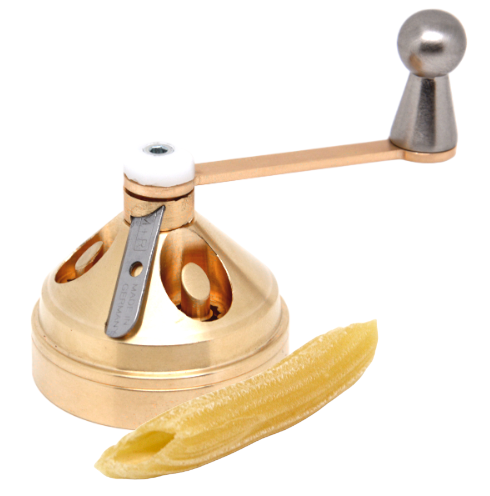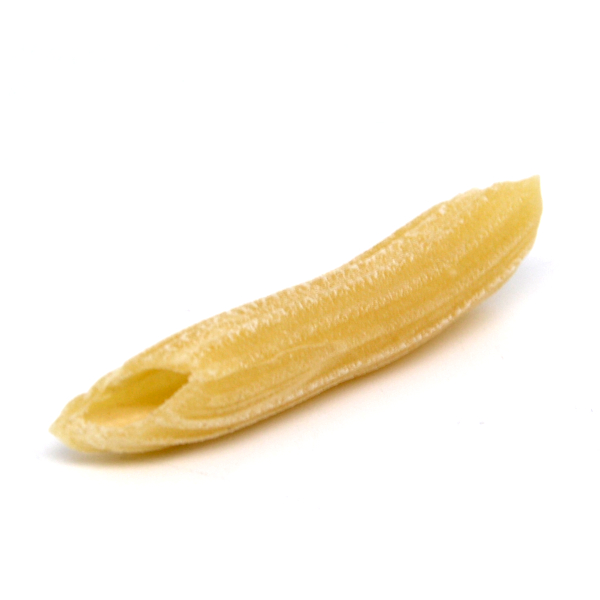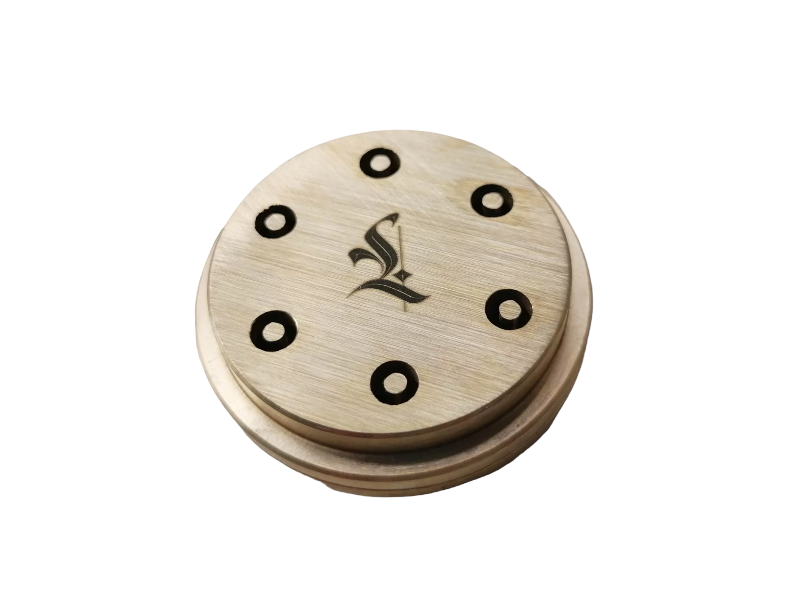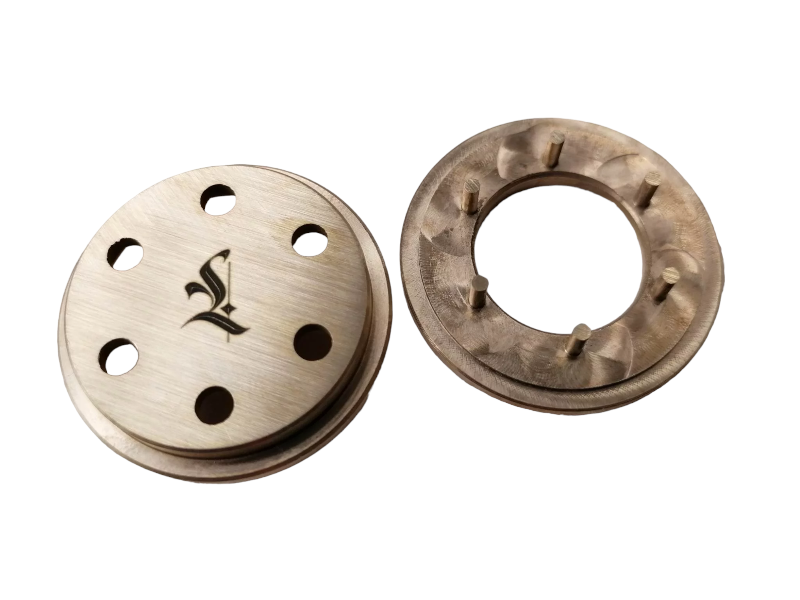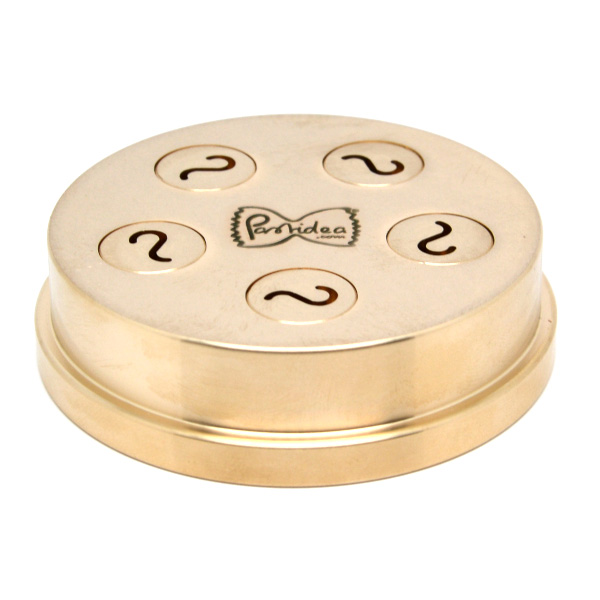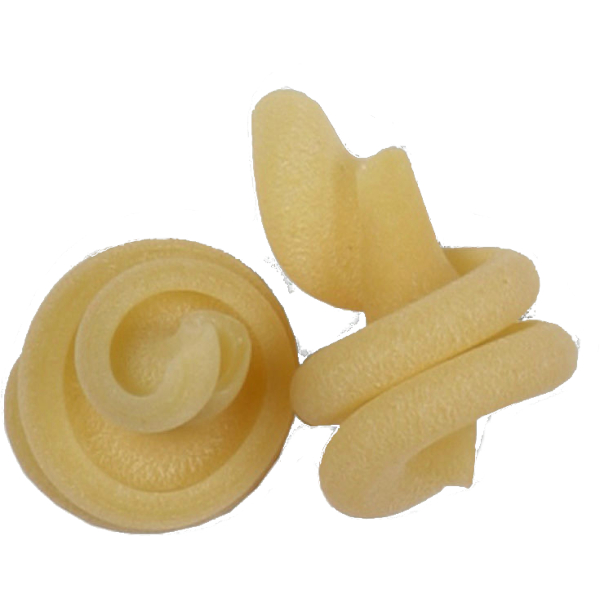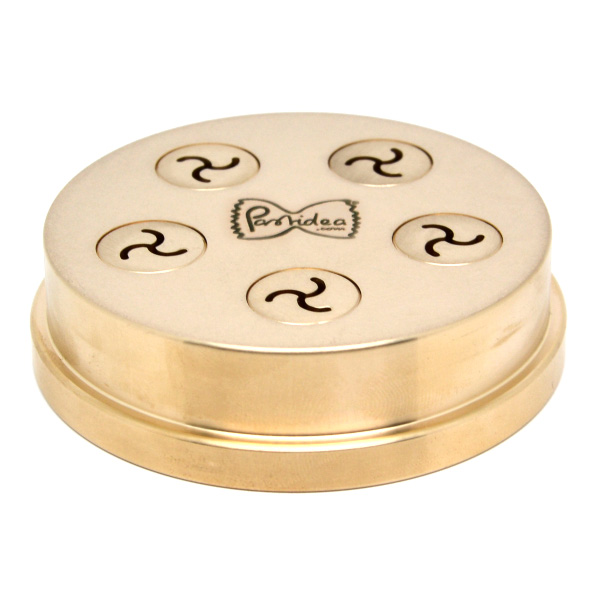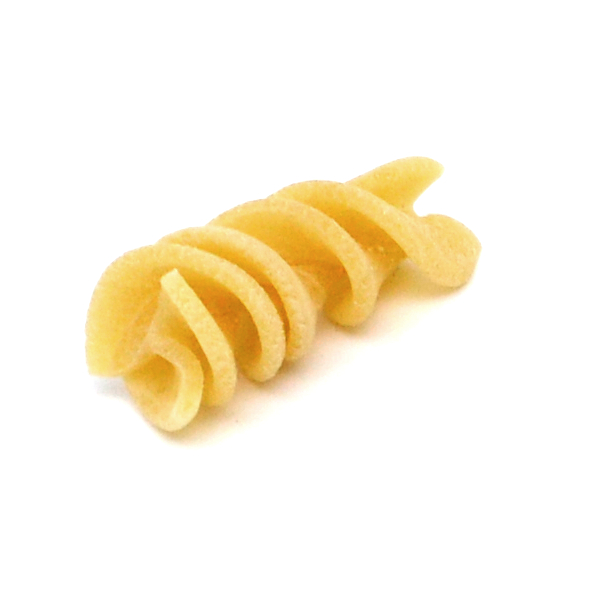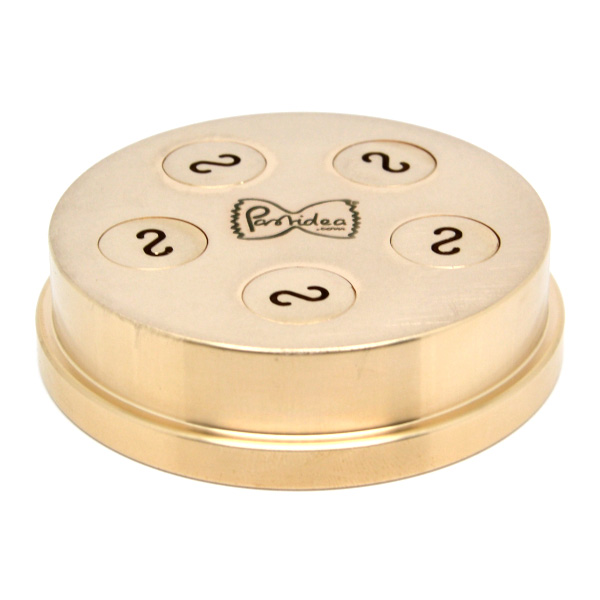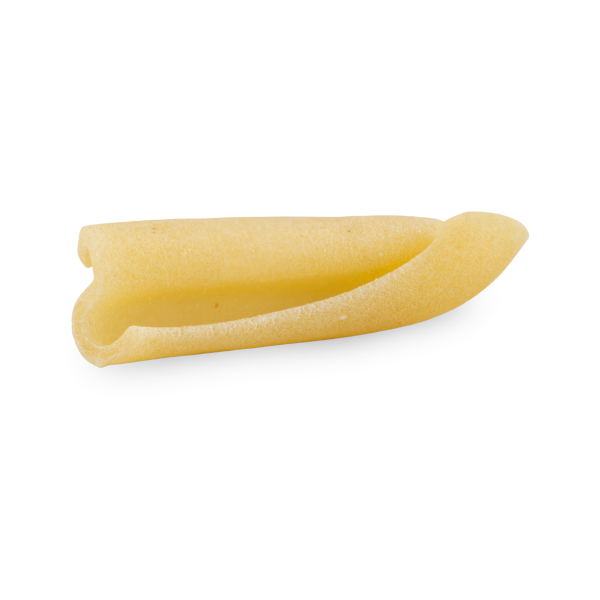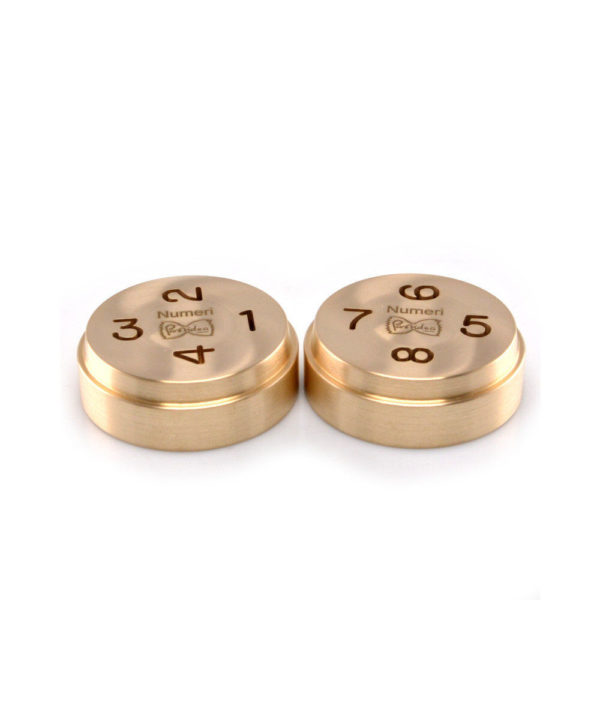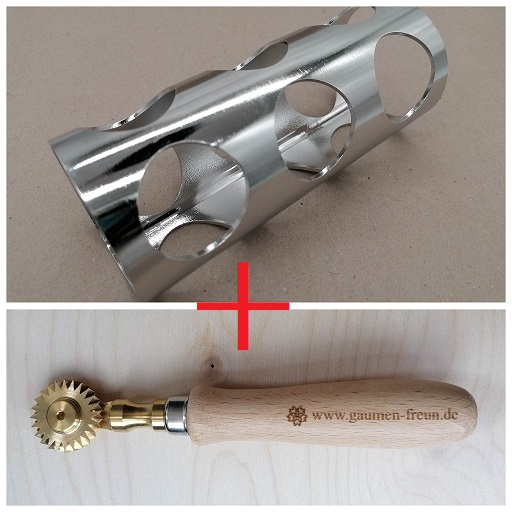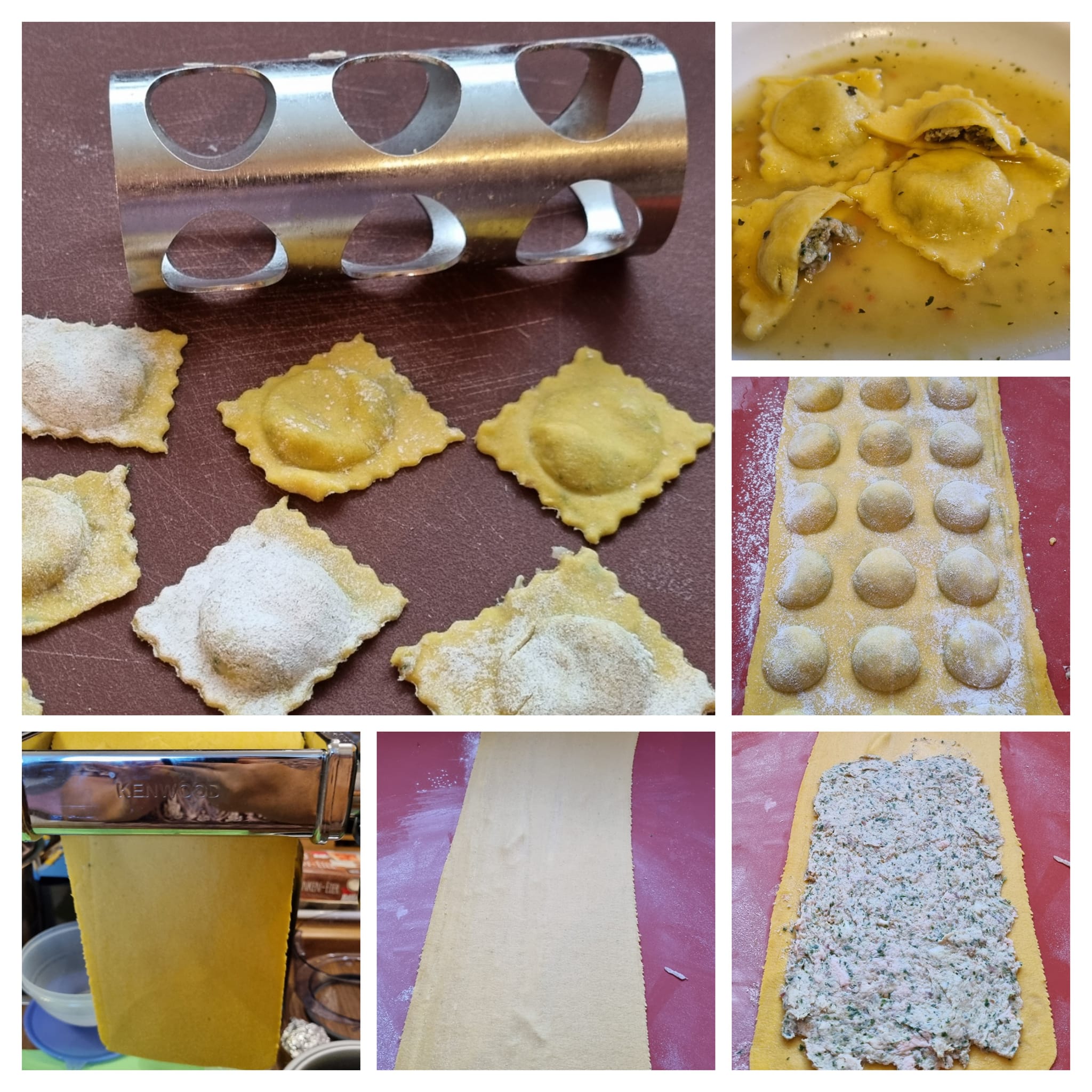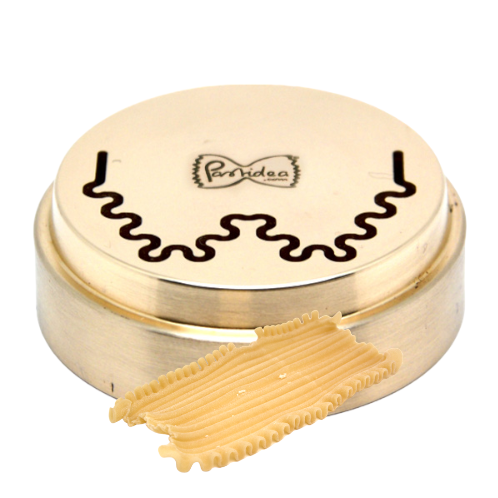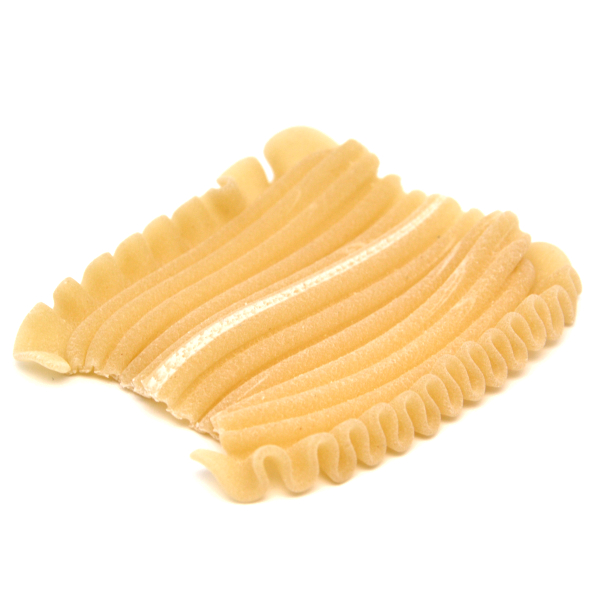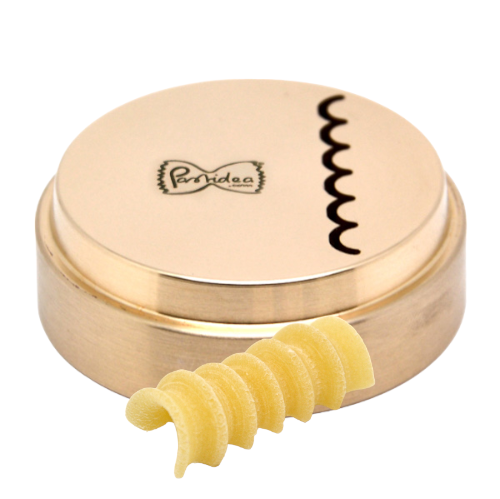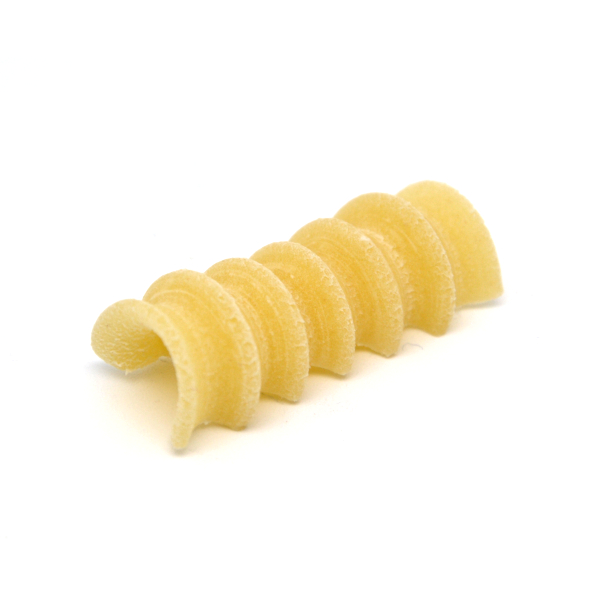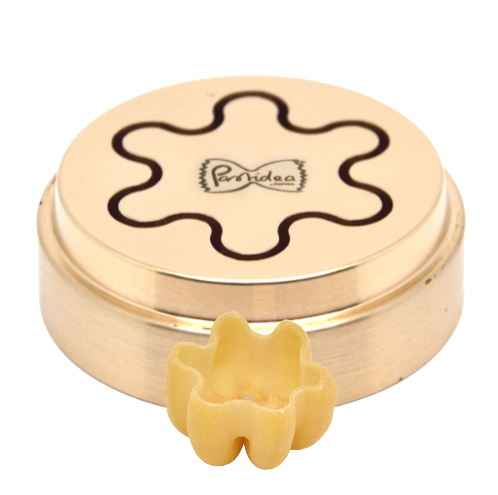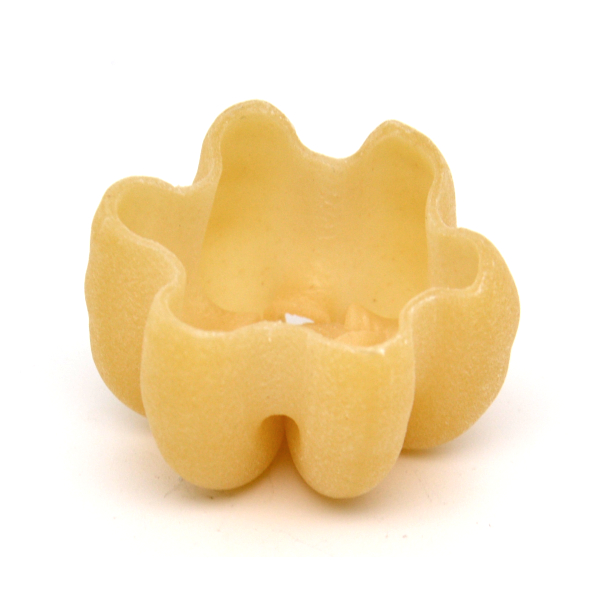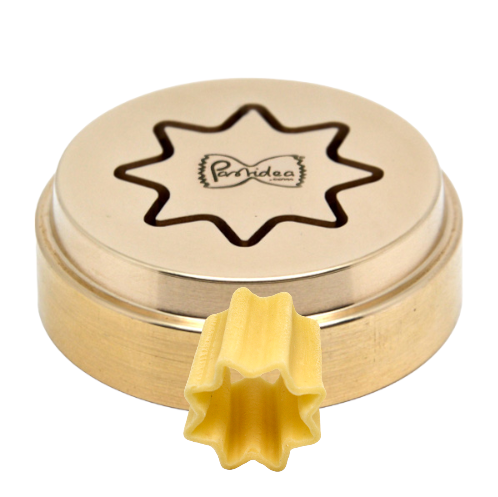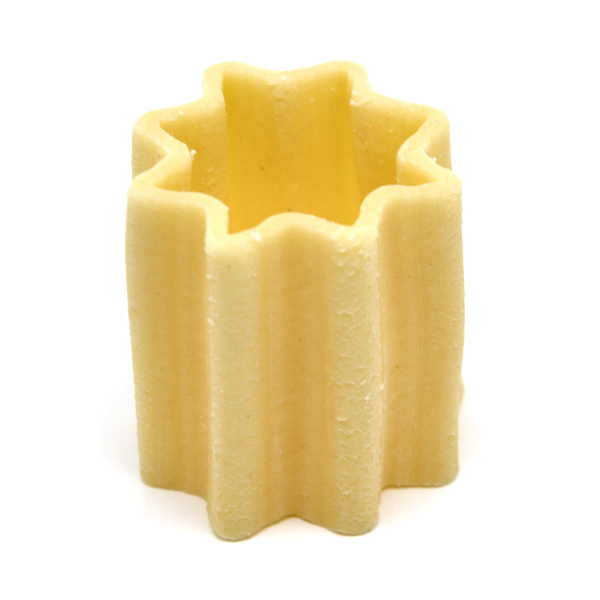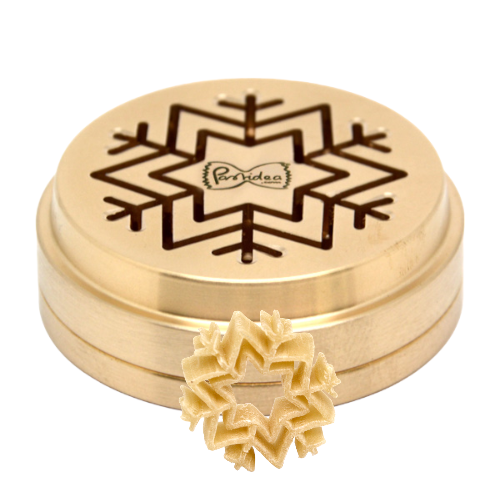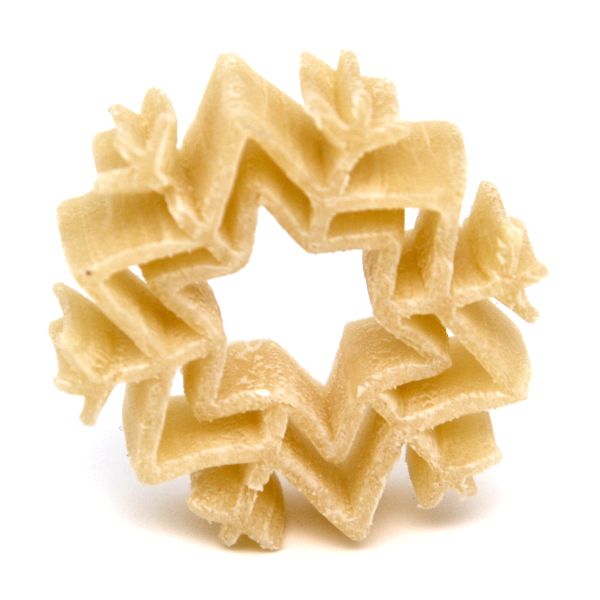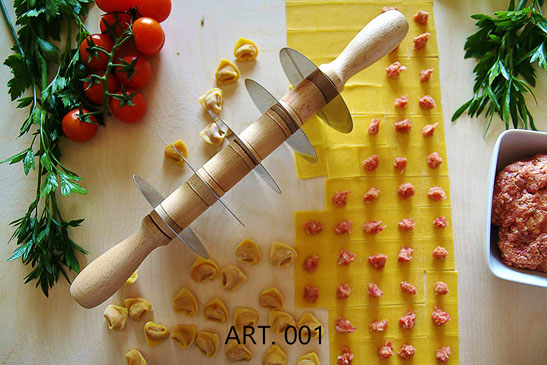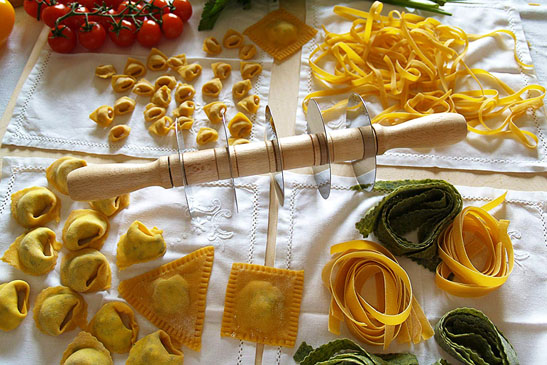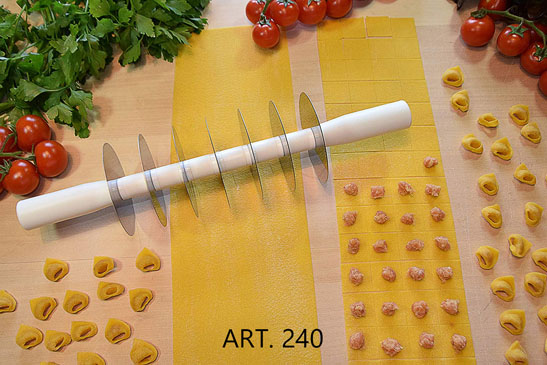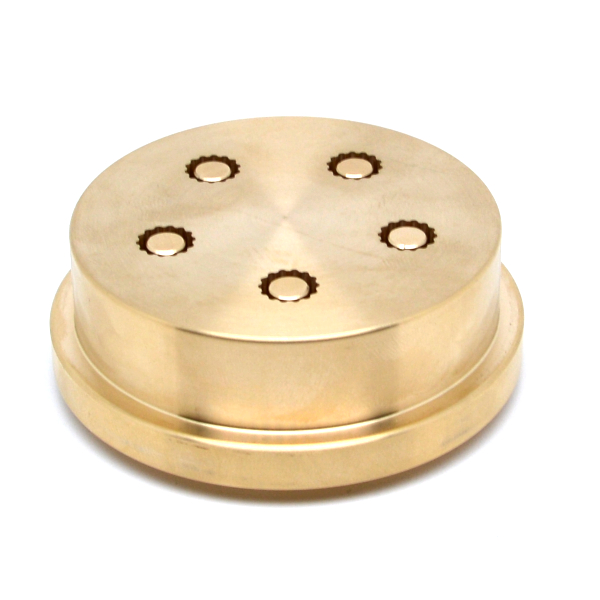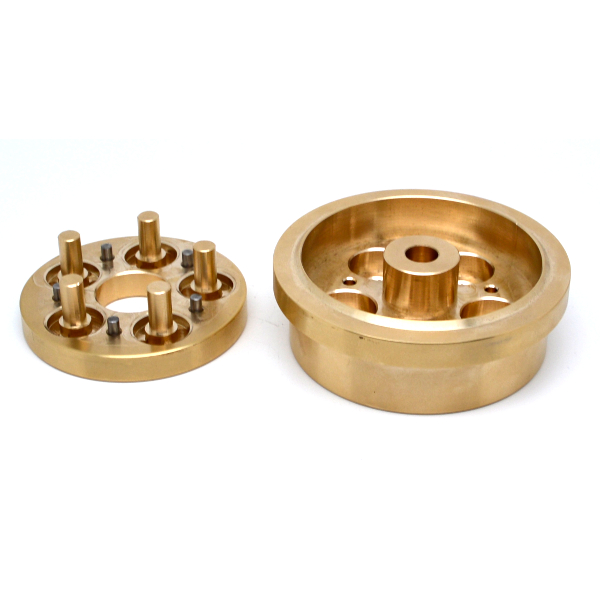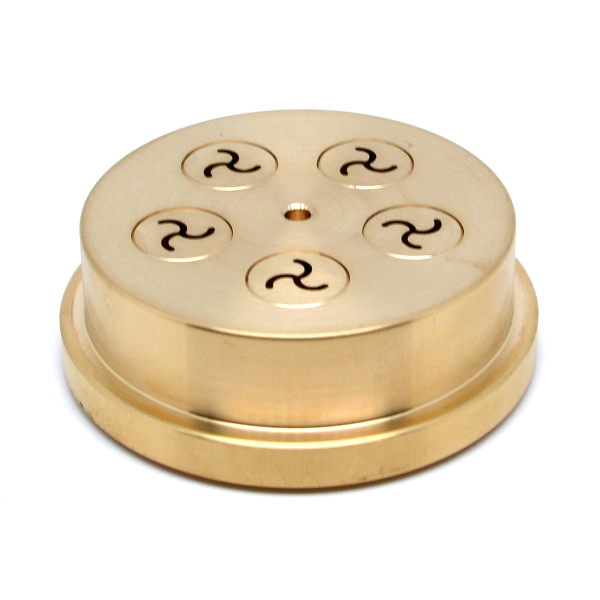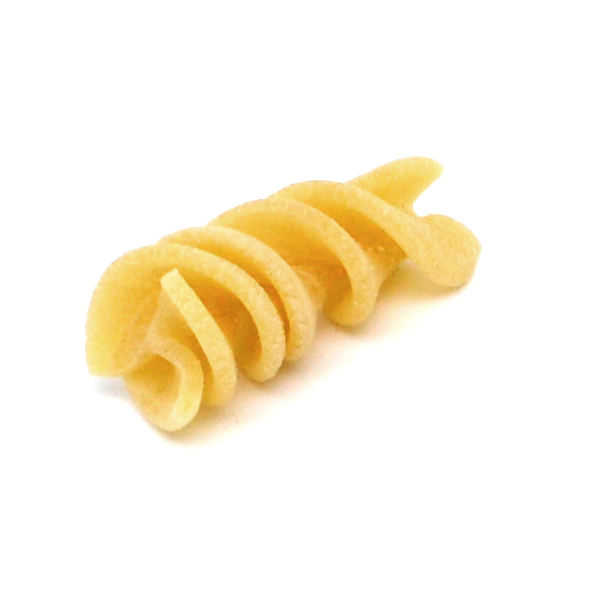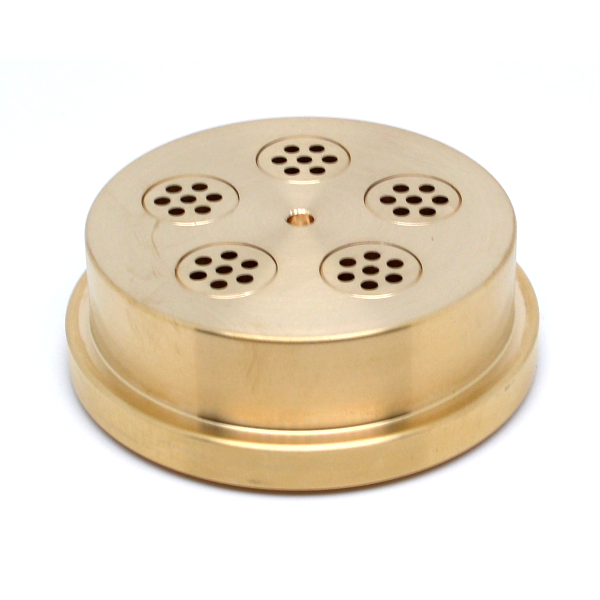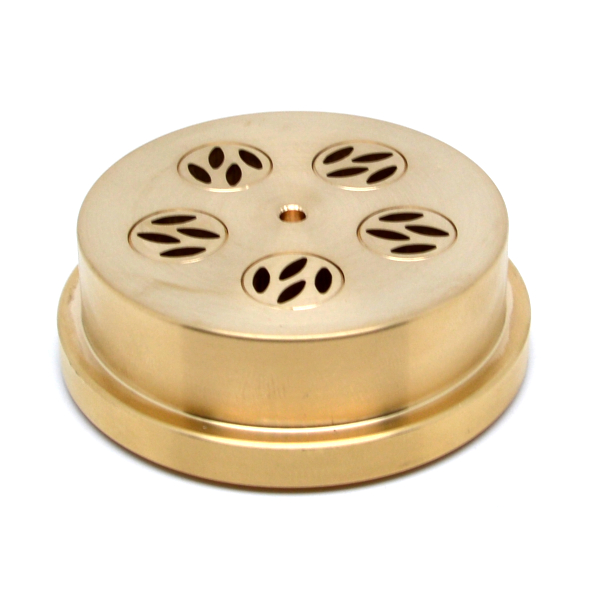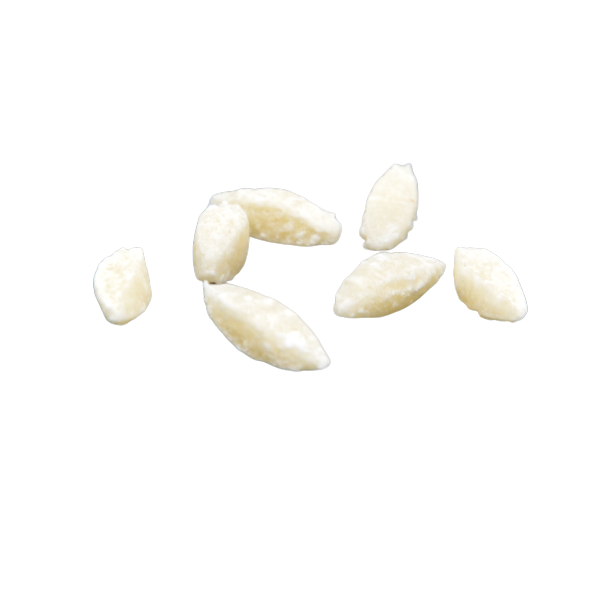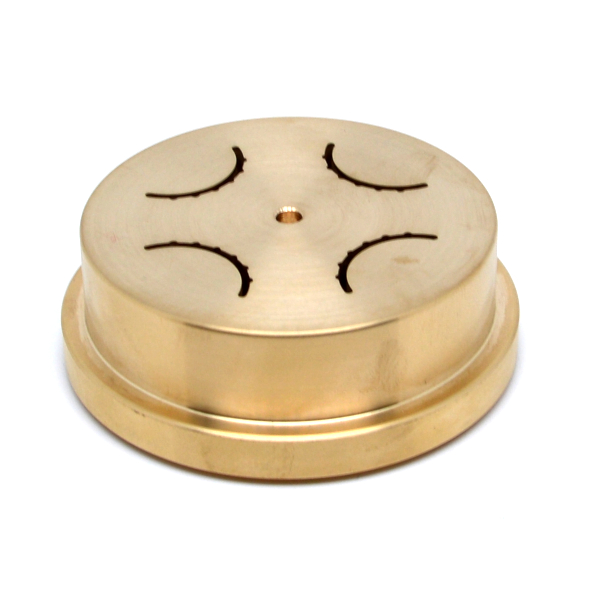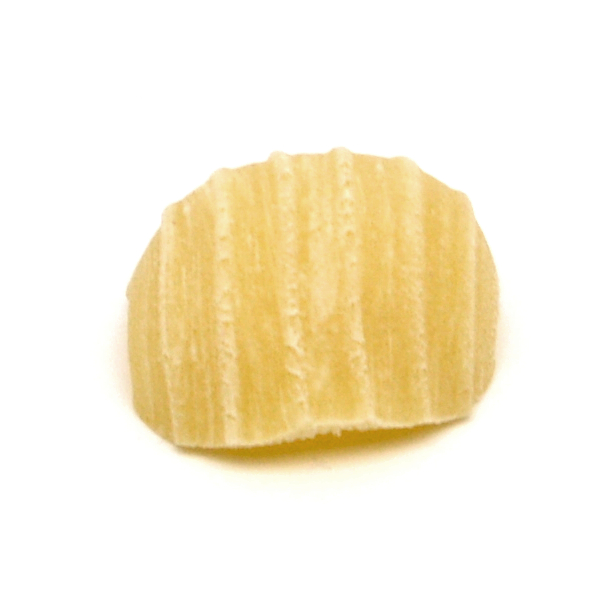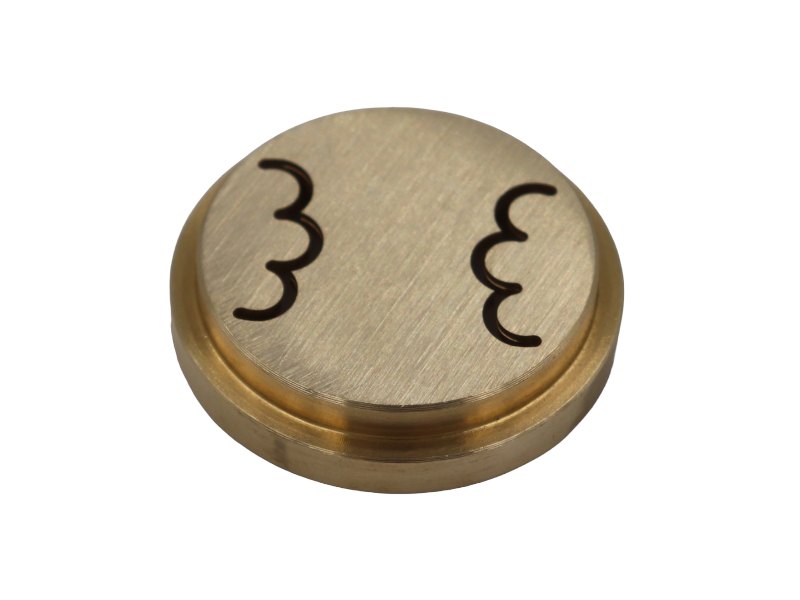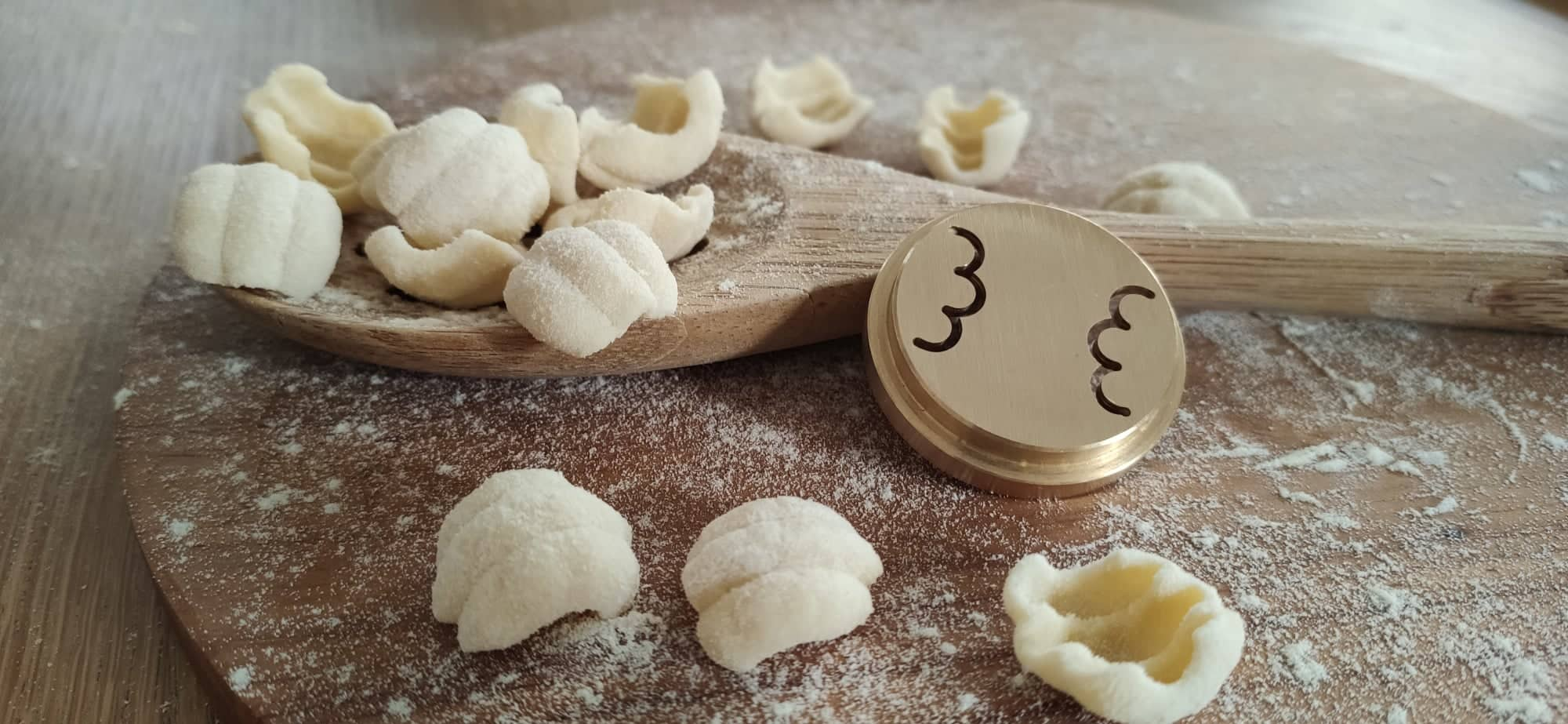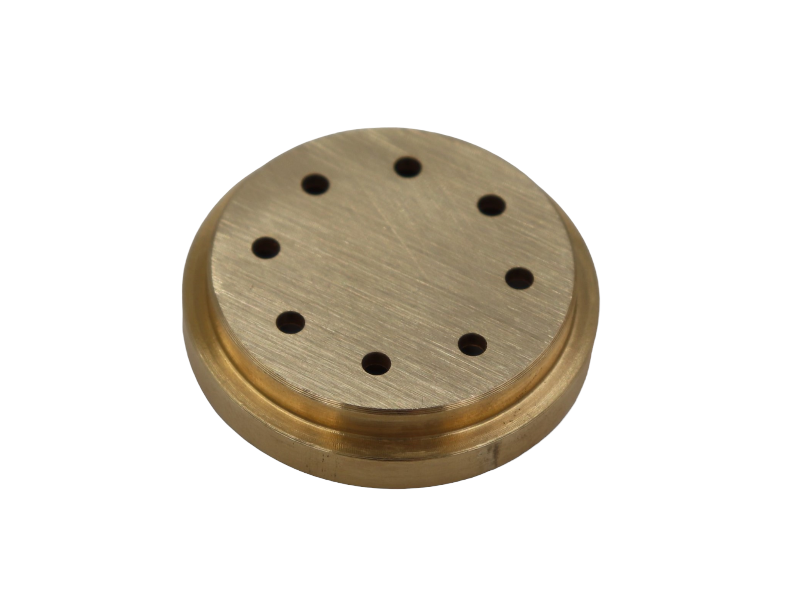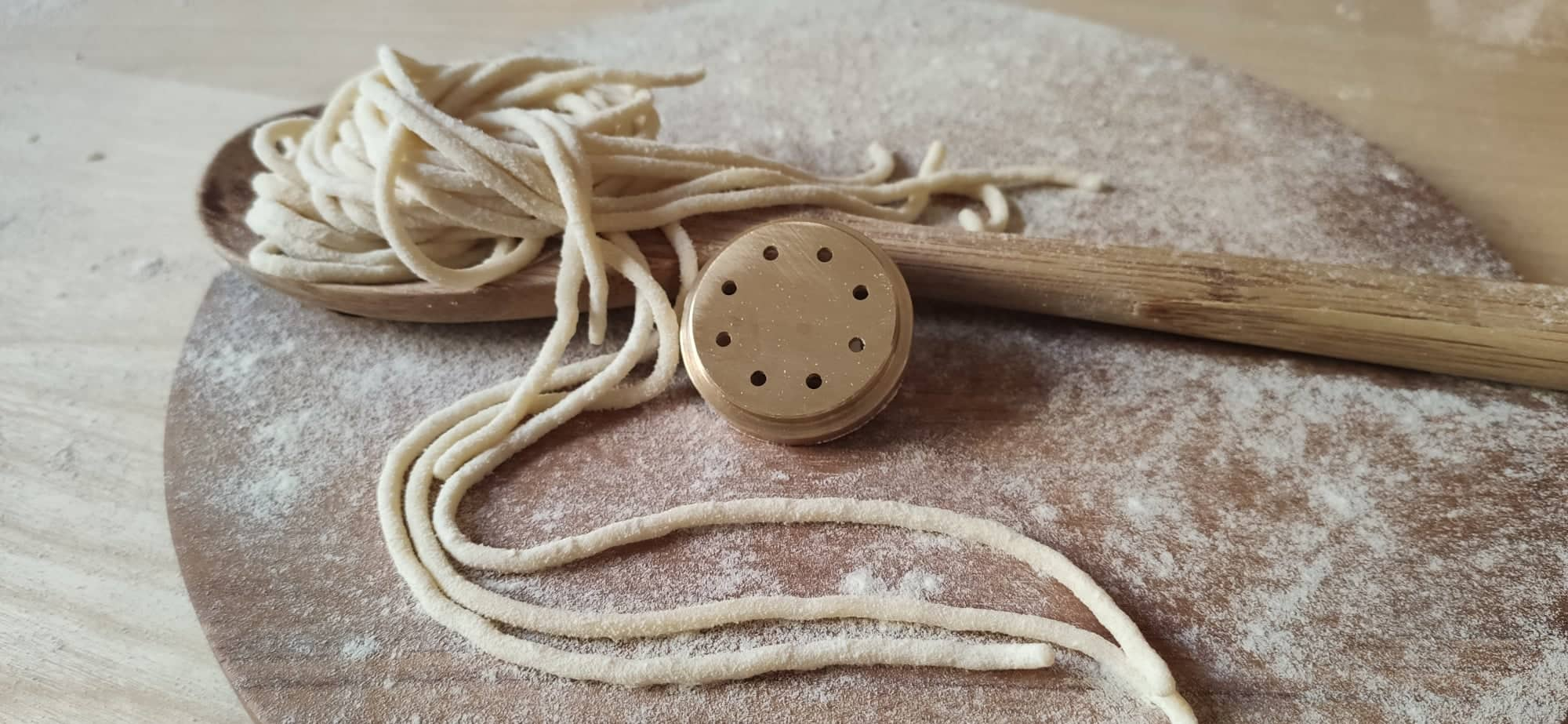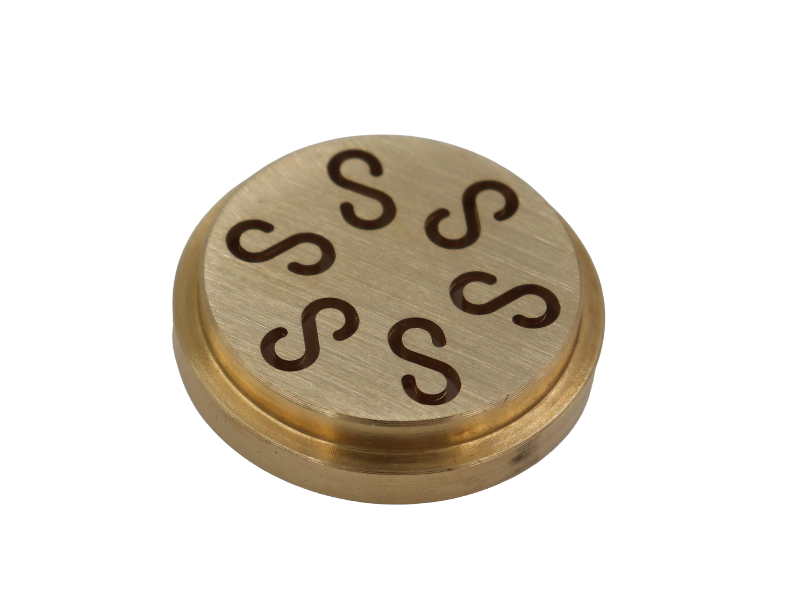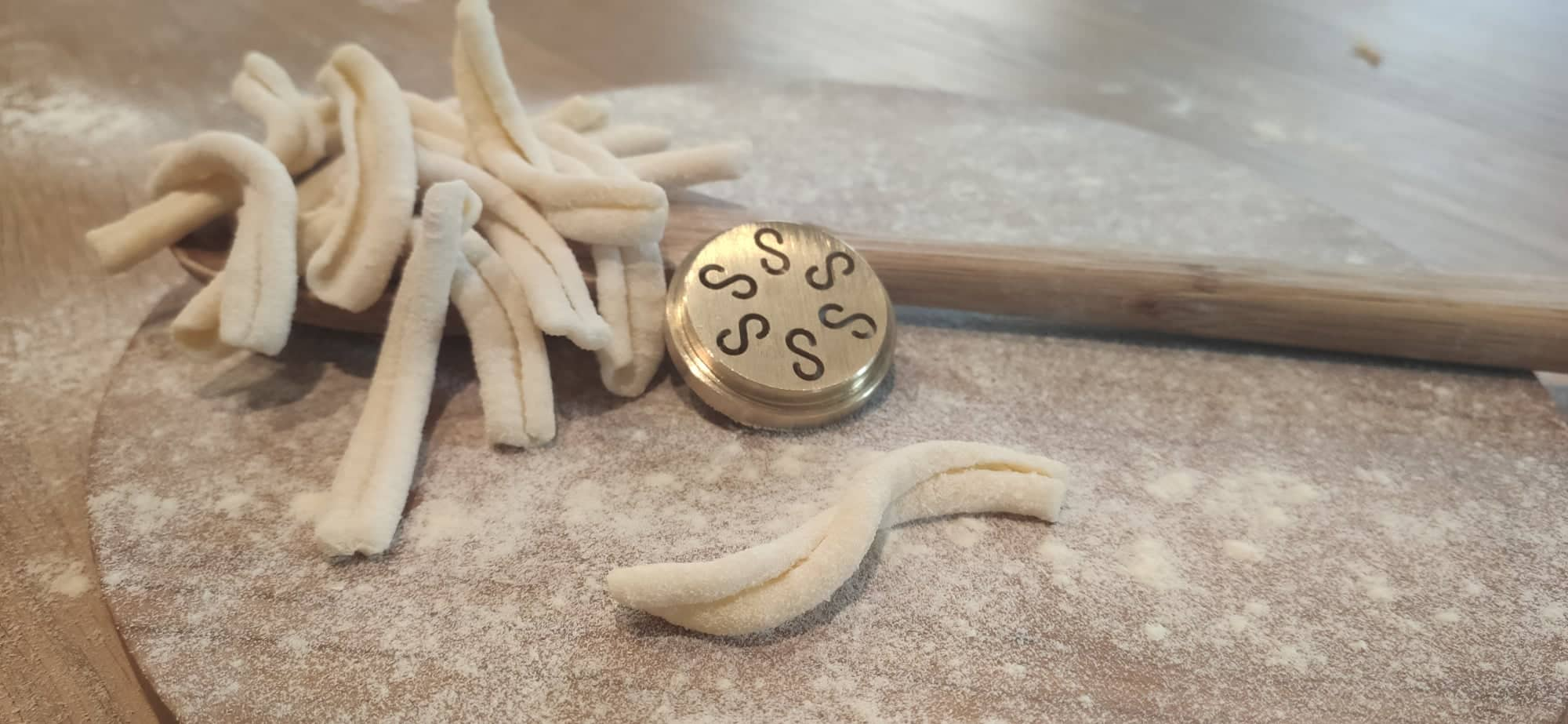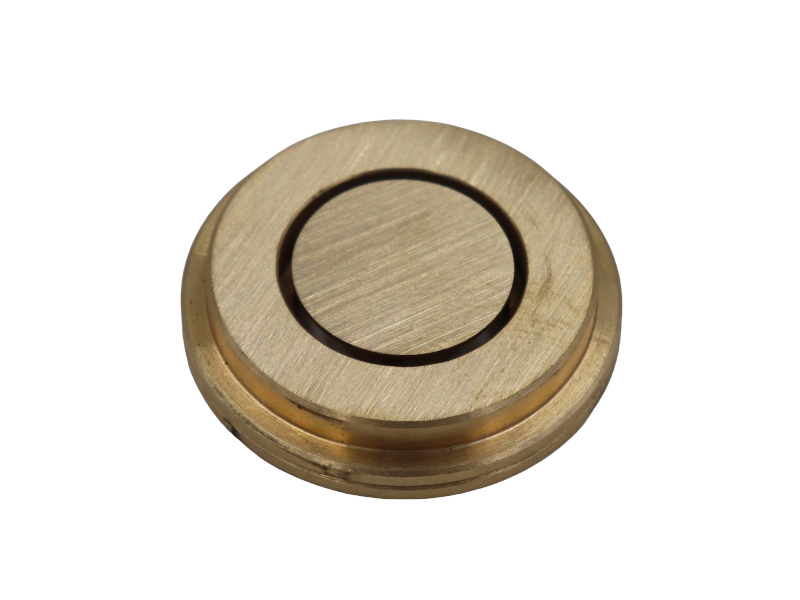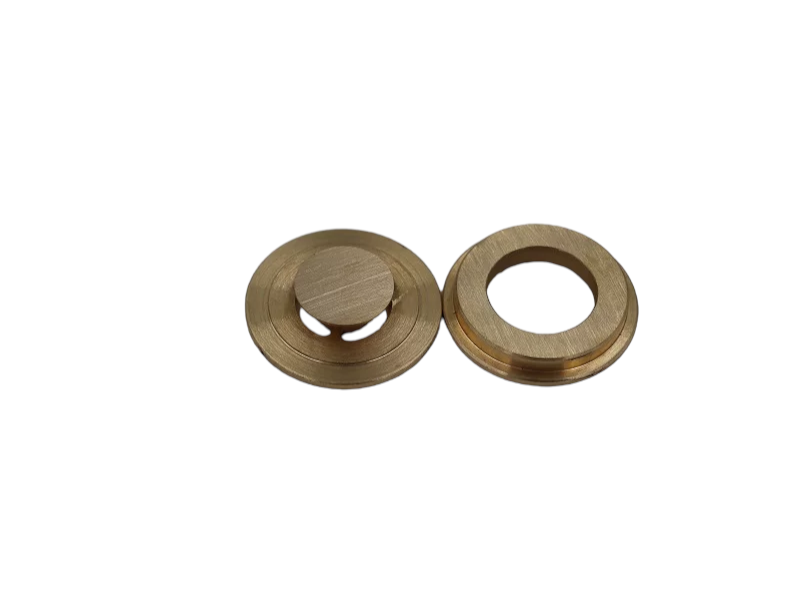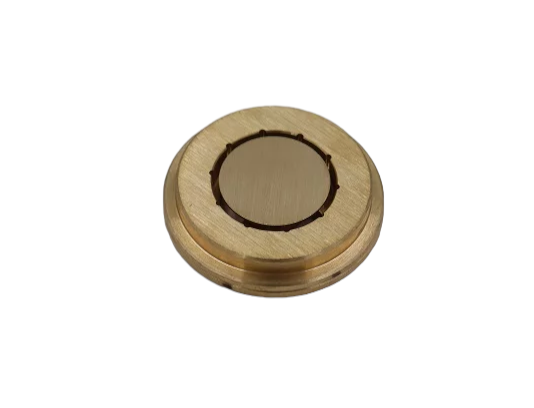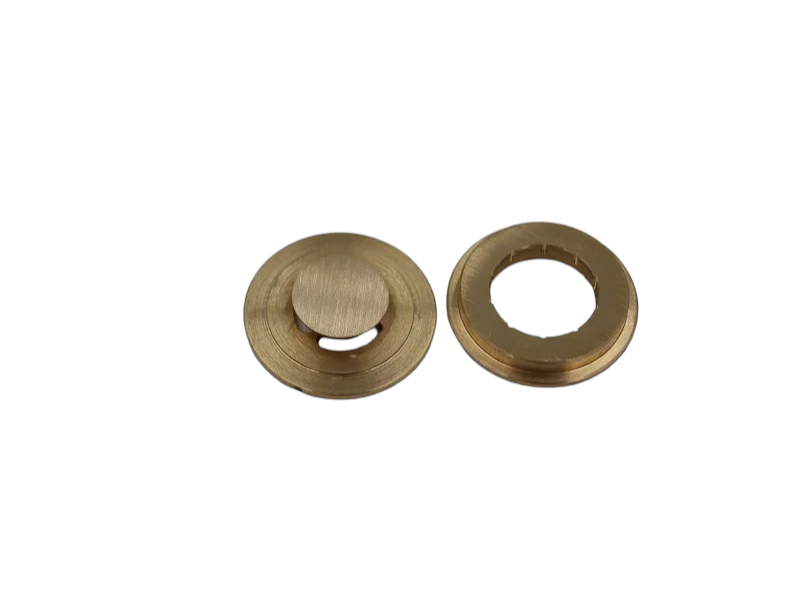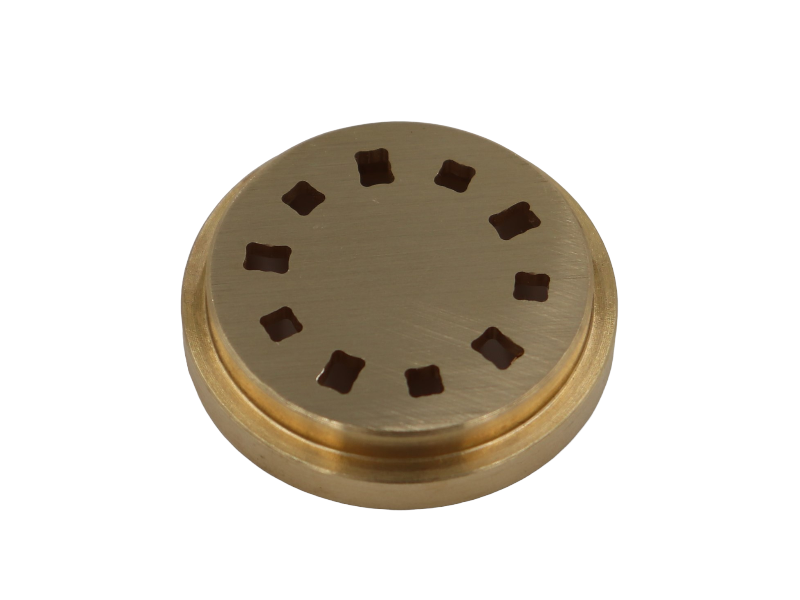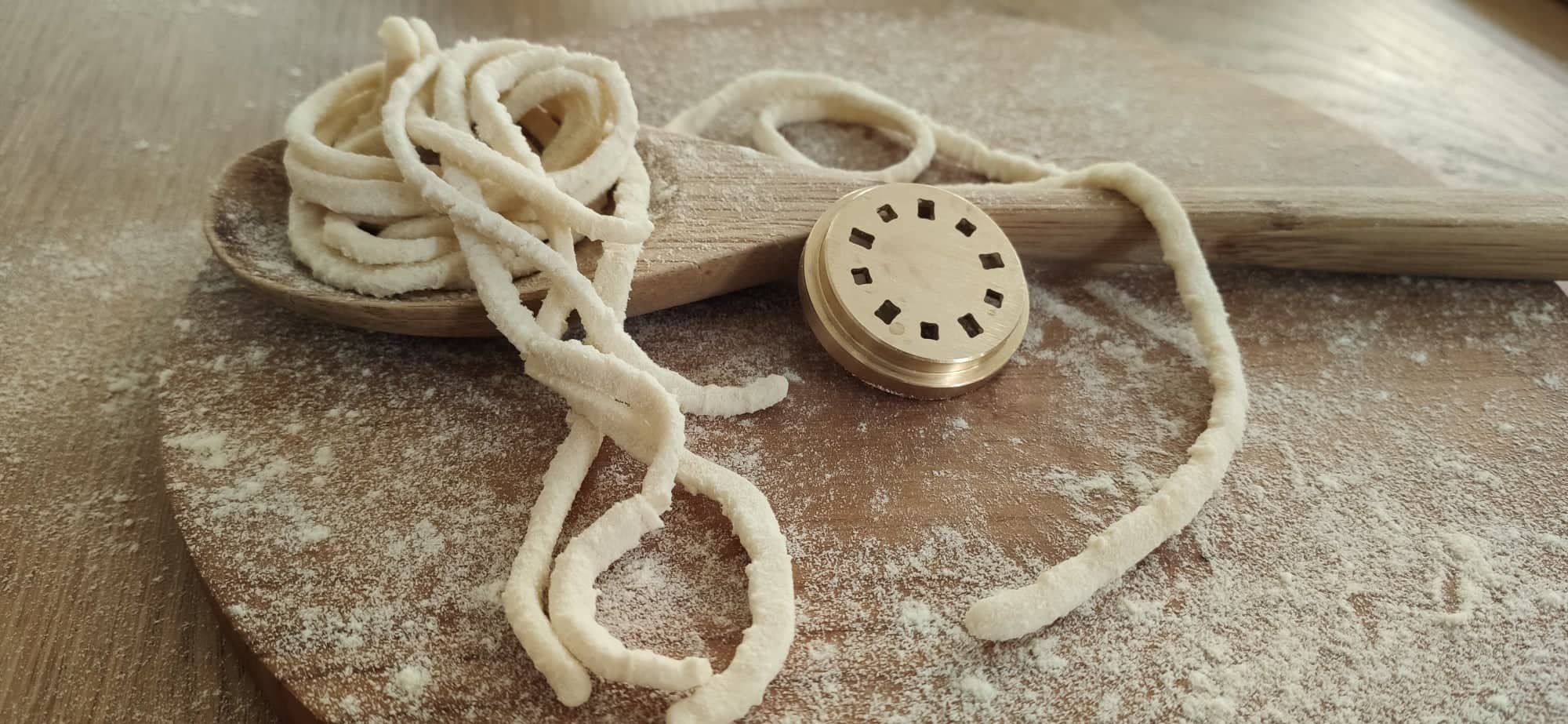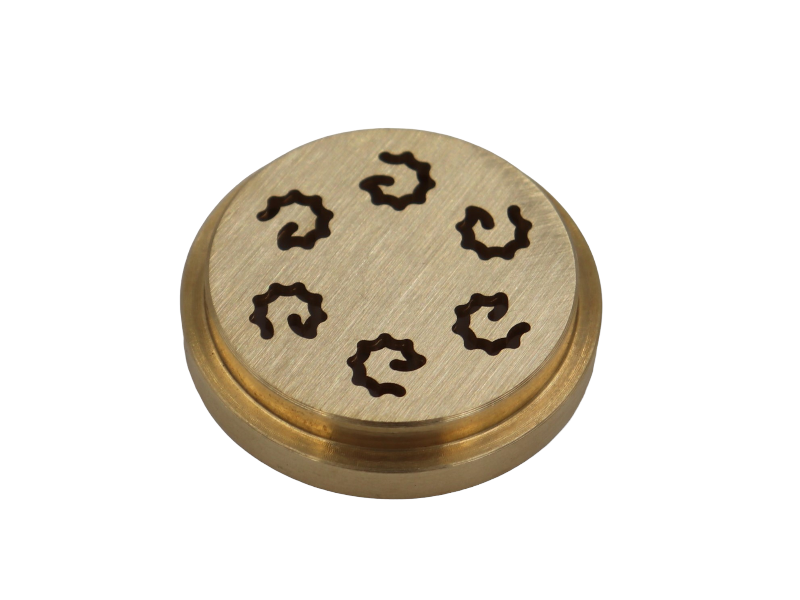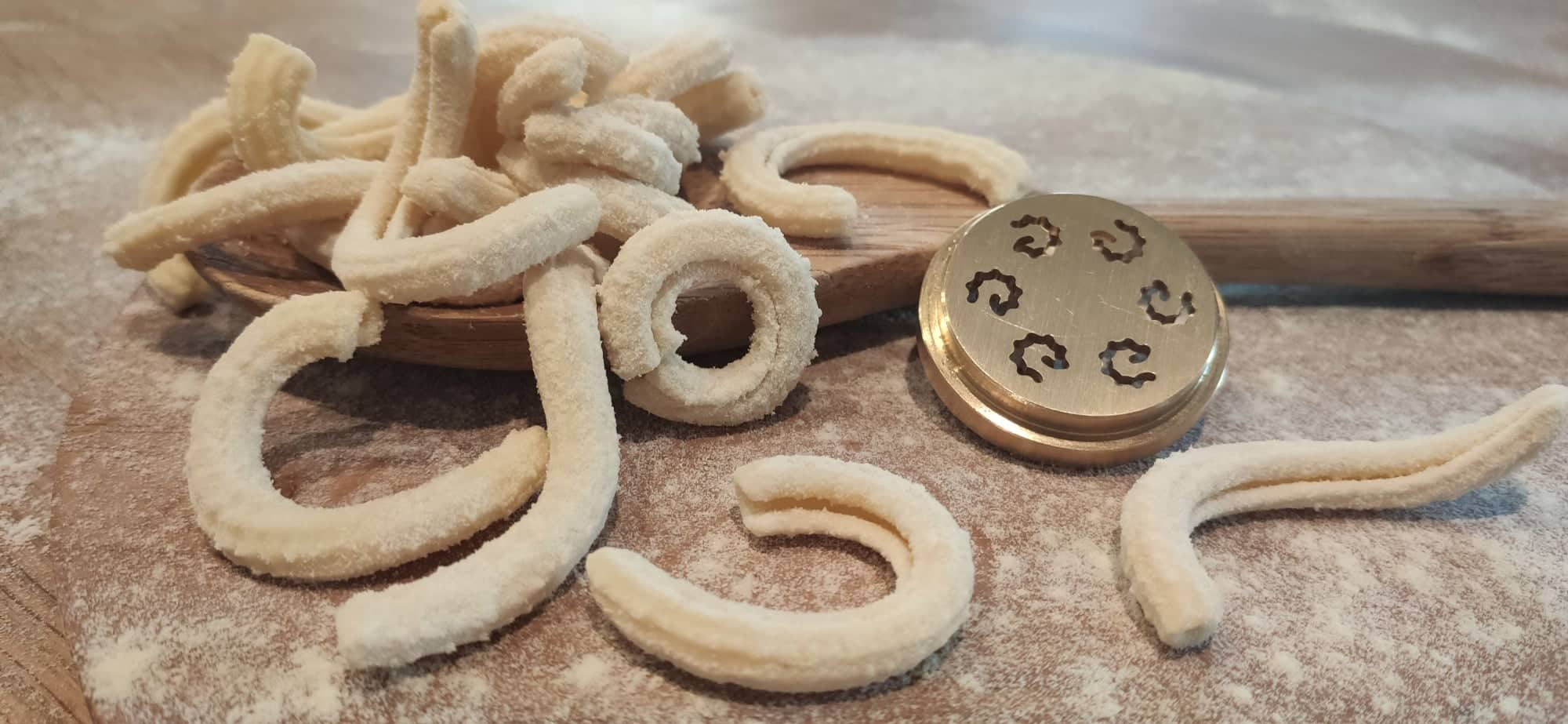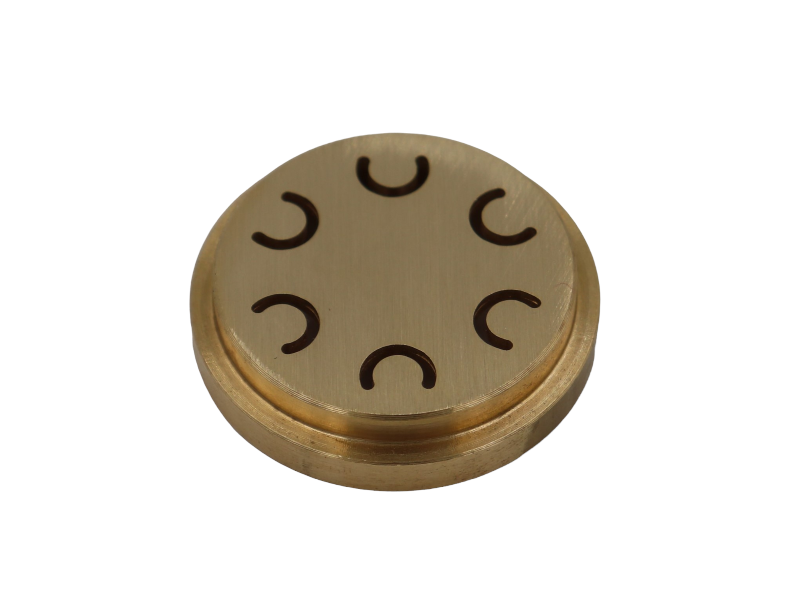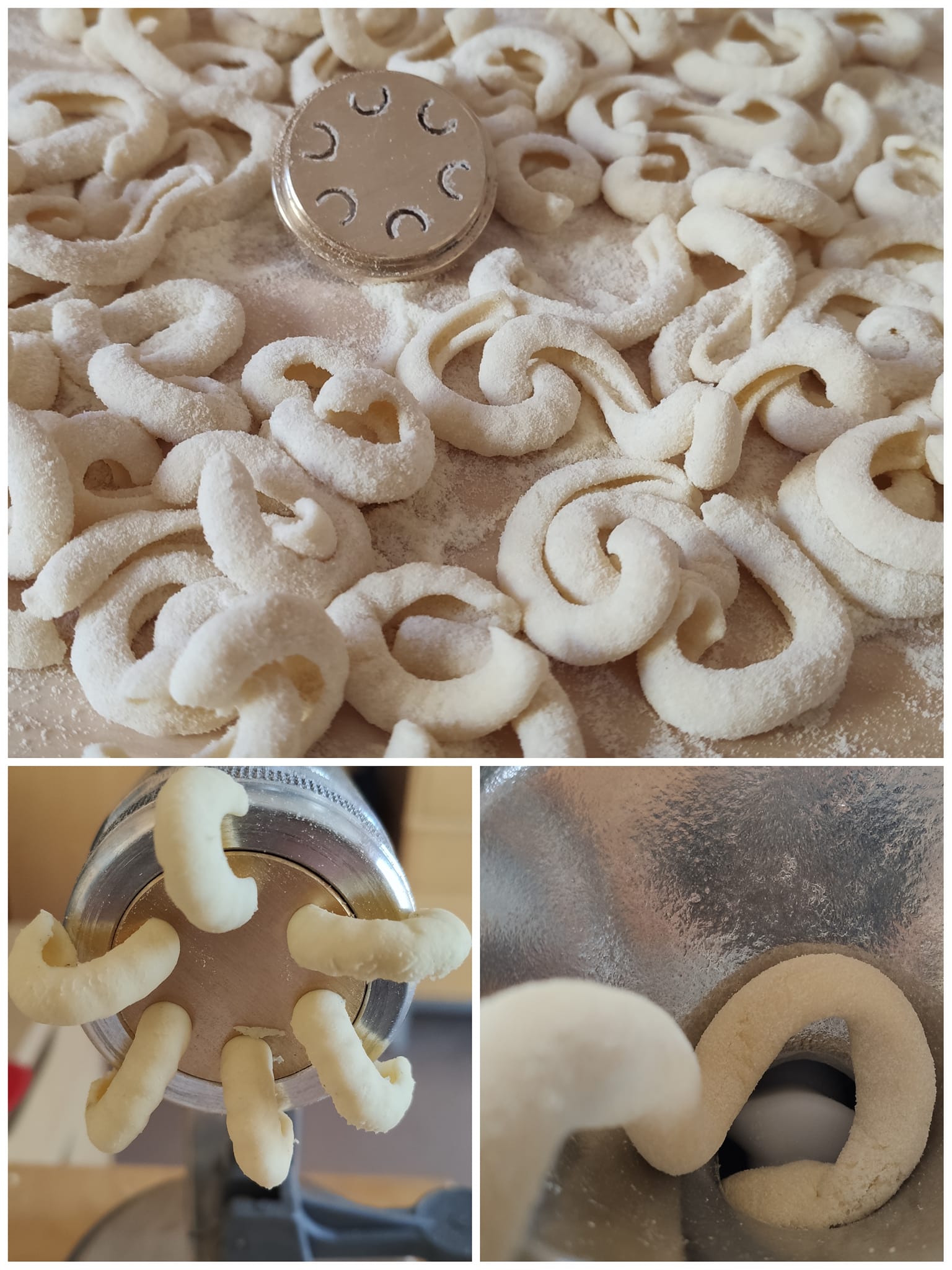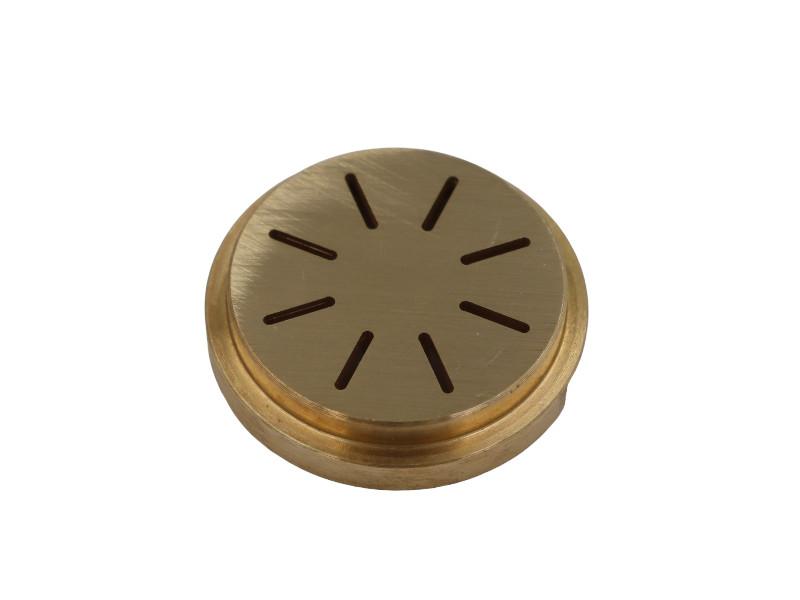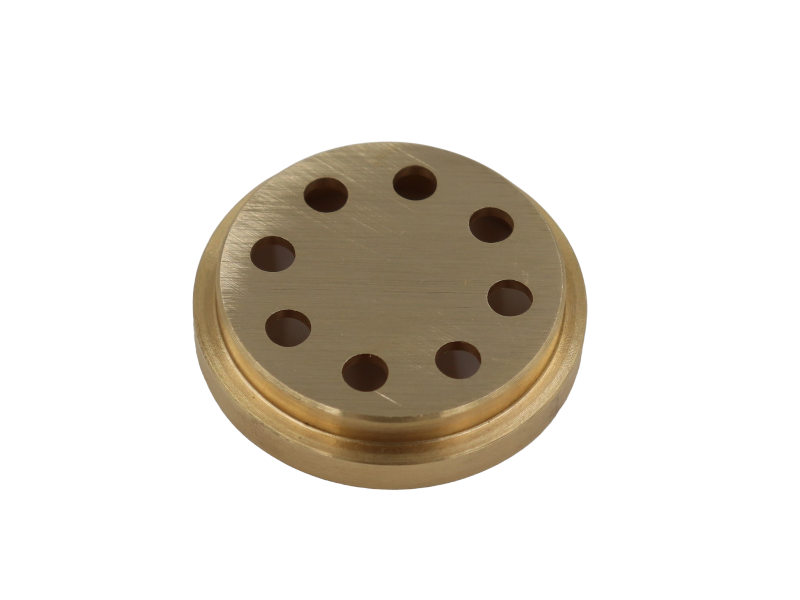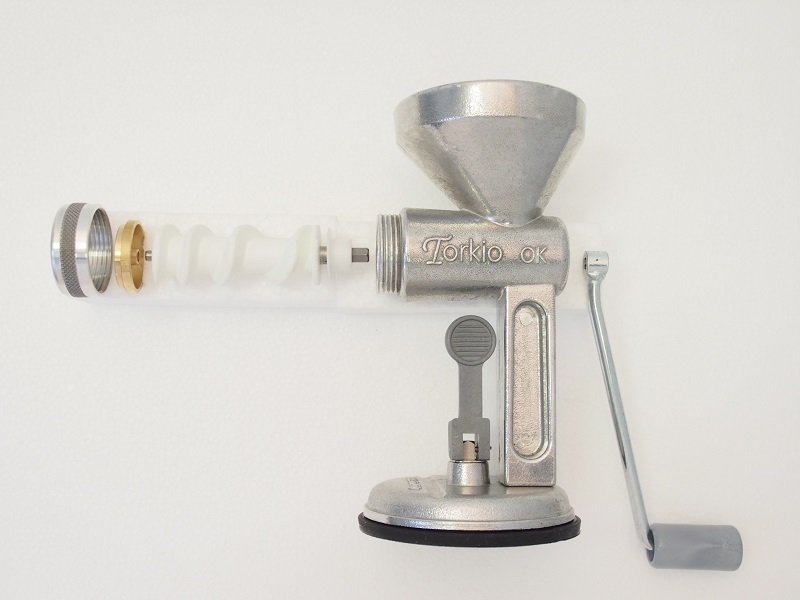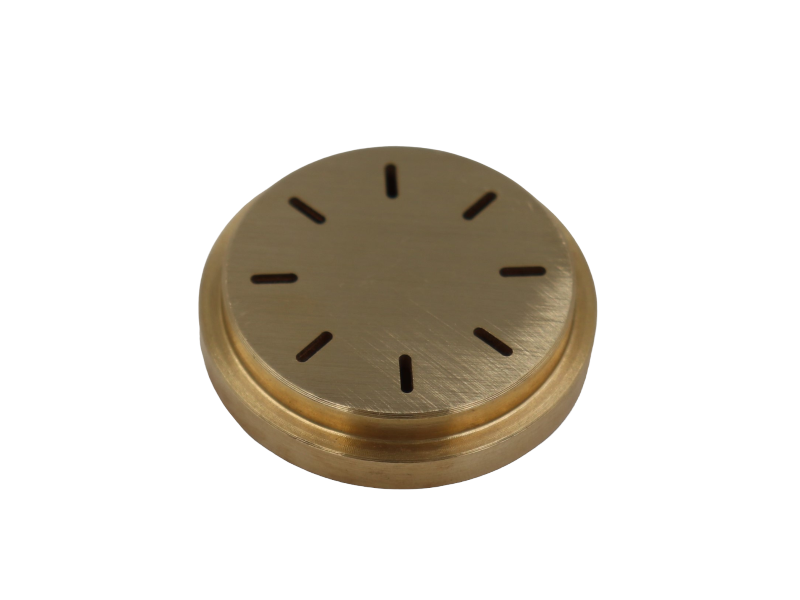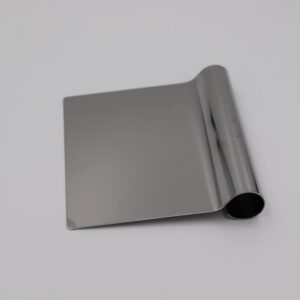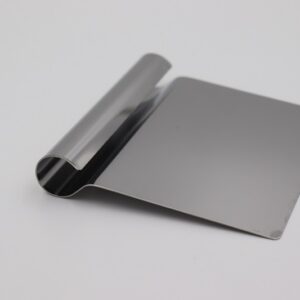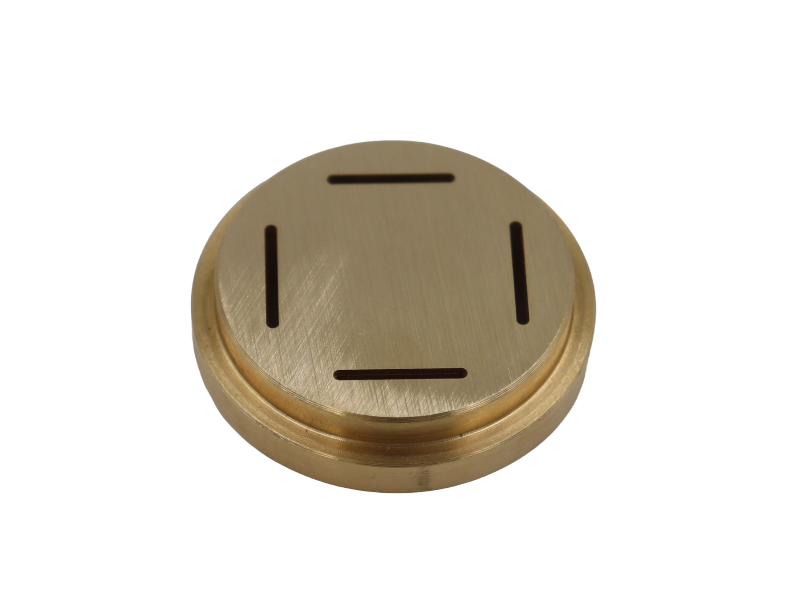49,90 € incl. VAT plus shipping costs
VAT included
excl. Shipping Rate
Bronze die, penne rigate / penne with a ridged surface Size 9 mm/pasta wall thickness 1 mm Pasta insert for Kenwood With an adapter, the die can be used in many other pasta machines, e.g. Philips Pastamaker Avance, Philips Viva, KitchenAid, Simac, Ariete, Unold, La Fattorina, Firmar, TR50, Häussler, Korngold, Omega Who doesn't know it: Penne. One of the most famous pastas in Germany is penne. The name comes from Latin. Because Penna is a feather and the ends of the pasta "Penne" are always cut at an angle, similar to a quill. If the ends weren't cut diagonally, you would be dealing with Maccheroni rigati. Thanks to the cavity and its ridges, penne can absorb a lot of sauce. They are often eaten with tomato sugo or an arrabiata. And they are also often seen in pasta salad. If the ends of the penne weren't cut diagonally, you would be dealing with Maccheroni rigati. Pasta insert for Kenwood AT910, AX910, KAX910ME, PP510, KAX92.AO, KAX91.A0ME. With an adapter, the die can be used in many other pasta machines, e.g. Philips Pastamaker Avance, Philips Viva, KitchenAid, Simac, Ariete, Unold, La Fattorina, Firmar, TR50, Häussler, Korngold, Omega. Why bronze: Bronze dies were the traditional way of making pasta. The pasta made “al bronzo” can only be found rarely and usually only in selected delicatessens. By pressing the pasta dough through the bronze matrices, the surface of the pasta is slightly roughened at the same time, making the pasta easier to grip. This allows the pasta to better absorb the sauce, flavors and spices later on. Would you like to learn more about bronze matrices? Then we recommend this article to you here. Recipe: It is recommended to use durum wheat semolina, enough cold liquid such as water and/or egg. The dough should be kneaded for about 8-10 minutes, this is the only way the gluten from the durum wheat can fully develop. The result should be a moist, crumbly dough. You can find a standard recipe for our matrices here. The matrices can also be used to produce gluten-free pasta. Sustainability: The format of the pastide matrices was originally designed for the Kenwood Pastafresca. By using reducing rings, the bronze matrices can be used on almost all other common pasta machines. All you need is an adapter that fits the machine. This means that even if over time the pasta machine is replaced by a different model due to a defect or for other reasons: the bronze die remains and can continue to be used in the future. Please note: Please note that the matrices may have small dark spots due to the material and production. This is due to the material and does not affect the function in any way. The matrices are not dishwasher safe. Should be dried immediately after cleaning to avoid water stains.
18,90 € incl. VAT plus shipping costs
VAT included
excl. Shipping Rate
Pasta insert for the Leonardo - Torkio OK hand crank machine Bucatini / fork spaghetti - 1 die - 2 formats: Cut short you get Gramigna or in Germany called Gabelspaghetti. When cut long you get Bucatini (Bucatini are thick spaghetti with a hole). Die only suitable for this pasta press! Why bronze: Bronze matrices were the traditional way of making pasta. The pasta made “al bronzo” can only be found rarely and usually only in selected delicatessens. By pressing the pasta dough through the bronze dies, the surface of the pasta is slightly roughened and the pasta becomes more grippy. This allows the pasta to absorb the sauce, flavors and spices better later. Storage: Do you have several bronze matrices and are you looking for storage to protect the matrix from dust and darkening due to the effects of light? Then we recommend our storage systems, which you can also find in our range.
99,00 € incl. VAT plus shipping costs
VAT included
excl. Shipping Rate
Bronze die Funghi / Trottole 10mm TR75 “Funghi” means nothing other than “mushrooms”. In Germany they are also known as Hütchennudeln, Schneckle or Trulli. In Italy you can also find them under the name Insalatonde (which is also the umbrella term for pasta salad pasta) and Cappelletti. Bronze die Funghi 10mm. Size: 10 mm Thickness: 1,1 mm Diameter die: 75 mm Pasta insert for the following professional pasta machines: TR75 Sela TR75 La Pastaia TR75 Avancini TR75 Korngold TR75 Omegaone TR75 No adapter or similar is required. The die fits directly into the above-mentioned pasta machines. Why bronze: Bronze matrices were the traditional way of making pasta. The pasta made “al bronzo” can only be found rarely and usually only in selected delicatessens. By pressing the pasta dough through the bronze dies, the surface of the pasta is slightly roughened and the pasta becomes more grippy. This allows the pasta to absorb the sauce, flavors and spices better later. Recipe: It is recommended to use durum wheat semolina, sufficiently cold liquid such as water and/or egg. The dough should be kneaded for about 8-10 minutes so that the gluten from the durum wheat can fully develop. The result should be a moist, crumbly dough. We recommend the following standard recipe for our matrices: Ingredients: 250 g durum wheat semolina or Semola rimacinata Select ONE of the following ingredients: 100 ml cold water or 110 ml liquid consisting of two eggs, the rest of the water, whisk lightly Instructions: Please only use cold liquids . Avoid flour, replace it with semolina. Use binding agents such as xanthan gum, gluten, etc. only to a limited extent, a maximum of 1 teaspoon per 500 grams of dry ingredients. Otherwise the dough will be too firm and the dies could break. If you knead the dough for longer or let it rest, the gluten will develop on its own. You can recognize a good pasta dough by the fact that it is moist and crumbly. The production of gluten-free pasta is also possible with the matrices. Storage: Do you have several bronze matrices and are looking for storage to protect the matrix from dust and darkening caused by light? Then we recommend our storage systems, which you will find in our range.
99,00 € incl. VAT plus shipping costs
VAT included
excl. Shipping Rate
Bronze die Fusilli A3, 10mm TR75 One of the most famous noodles in Germany is fusilli. They are often called Spirelli, Rotini and rarely Eliche. The twists allow the sauce to combine particularly well with the pasta. Fusillis are easy to dry. Bronze die Fusilli A3 10mm. Size: 10 mm Thickness: 1,1 mm Diameter die: 75 mm Pasta insert for the following professional pasta machines: TR75 Sela TR75 La Pastaia TR75 Avancini TR75 Korngold TR75 Omegaone TR75 No adapter or similar is required. The die fits directly into the above-mentioned pasta machines. Why bronze: Bronze matrices were the traditional way of making pasta. The pasta made “al bronzo” can only be found rarely and usually only in selected delicatessens. By pressing the pasta dough through the bronze dies, the surface of the pasta is slightly roughened and the pasta becomes more grippy. This allows the pasta to absorb the sauce, flavors and spices better later. Recipe: It is recommended to use durum wheat semolina, sufficiently cold liquid such as water and/or egg. The dough should be kneaded for about 8-10 minutes so that the gluten from the durum wheat can fully develop. The result should be a moist, crumbly dough. We recommend the following standard recipe for our matrices: Ingredients: 250 g durum wheat semolina or Semola rimacinata Select ONE of the following ingredients: 100 ml cold water or 110 ml liquid consisting of two eggs, the rest of the water, whisk lightly Instructions: Please only use cold liquids . Avoid flour, replace it with semolina. Use binding agents such as xanthan gum, gluten, etc. only to a limited extent, a maximum of 1 teaspoon per 500 grams of dry ingredients. Otherwise the dough will be too firm and the dies could break. If you knead the dough for longer or let it rest, the gluten will develop on its own. You can recognize a good pasta dough by the fact that it is moist and crumbly. The production of gluten-free pasta is also possible with the matrices. Storage: Do you have several bronze matrices and are looking for storage to protect the matrix from dust and darkening caused by light? Then we recommend our storage systems, which you can find in our range.
99,00 € incl. VAT plus shipping costs
VAT included
excl. Shipping Rate
Bronze matrix Casarecce, translates as “the homemade ones”, TR75 originally come from Sicily, but can also be found in central and southern Italy. Harmonize wonderfully with Ragu or any other sauce. Bronze casarecce die. Size: 8 mm Thickness: 1,1 mm Diameter die: 75 mm Pasta insert for the following professional pasta machines: TR75 Sela TR75 La Pastaia TR75 Avancini TR75 Korngold TR75 Omegaone TR75 No adapter or similar is required. The die fits directly into the above-mentioned pasta machines. Why bronze: Bronze matrices were the traditional way of making pasta. The pasta made “al bronzo” can only be found rarely and usually only in selected delicatessens. By pressing the pasta dough through the bronze dies, the surface of the pasta is slightly roughened and the pasta becomes more grippy. This allows the pasta to absorb the sauce, flavors and spices better later. Recipe: It is recommended to use durum wheat semolina, sufficiently cold liquid such as water and/or egg. The dough should be kneaded for about 8-10 minutes so that the gluten from the durum wheat can fully develop. The result should be a moist, crumbly dough. We recommend the following standard recipe for our matrices: Ingredients: 250 g durum wheat semolina or Semola rimacinata Select ONE of the following ingredients: 100 ml cold water or 110 ml liquid consisting of two eggs, the rest of the water, whisk lightly Instructions: Please only use cold liquids . Avoid flour, replace it with semolina. Use binding agents such as xanthan gum, gluten, etc. only to a limited extent, a maximum of 1 teaspoon per 500 grams of dry ingredients. Otherwise the dough will be too firm and the dies could break. If you knead the dough for longer or let it rest, the gluten will develop on its own. You can recognize a good pasta dough by the fact that it is moist and crumbly. The production of gluten-free pasta is also possible with the matrices. Storage: Do you have several bronze matrices and are looking for storage to protect the matrix from dust and darkening caused by light? Then we recommend our storage systems, which you can find in our range.
57,60 € incl. VAT plus shipping costs
VAT included
excl. Shipping Rate
Bronze die set of 2 numbers/numbers Perfect for your next noodle soup! Pasta insert for Kenwood AT910, AX910, KAX910ME, PP510, KAX92.AO, KAX91.A0ME. With an adapter, the die can be used in many other pasta machines, e.g. Philips Pastamaker Avance, Philips Viva, KitchenAid, Simac, Ariete, Unold, La Fattorina, Firmar, TR50, Häussler, Korngold, Omega. Why bronze: Bronze matrices were the traditional way of making pasta. The pasta made “al bronzo” can only be found rarely and usually only in selected delicatessens. By pressing the pasta dough through the bronze dies, the surface of the pasta is slightly roughened and the pasta becomes more grippy. This allows the pasta to absorb the sauce, flavors and spices better later. Recipe: It is recommended to use durum wheat semolina, sufficiently cold liquid such as water and/or egg. The dough should be kneaded for about 8-10 minutes so that the gluten from the durum wheat can fully develop. The result should be a moist, crumbly dough. We recommend the following standard recipe for our matrices: Ingredients: 250 g durum wheat semolina or Semola rimacinata Select ONE of the following ingredients: 100 ml cold water or 110 ml liquid consisting of two eggs, the rest of the water, lightly whisked Instructions: Please only use cold liquids . Avoid flour, replace it with semolina. Use binding agents such as xanthan gum, gluten, etc. only to a limited extent, a maximum of 1 teaspoon per 500 grams of dry ingredients. Otherwise the dough will be too firm and the dies could break. If you knead the dough for longer or let it rest, the gluten will develop on its own. You can recognize a good pasta dough by the fact that it is moist and crumbly. The production of gluten-free pasta is also possible with the matrices. Storage: Do you have several bronze matrices and are you looking for storage to protect the matrix from dust and darkening due to the effects of light? Then we recommend our storage systems, which you can also find in our range. Please note: Please note that the matrices may have small dark spots due to the material and production. This is due to the material and does not affect the function in any way. The matrices are not dishwasher safe. Should be dried immediately after cleaning to avoid water stains.
48,90 € incl. VAT plus shipping costs
VAT included
excl. Shipping Rate
The advantages of the material: Polished stainless steel - food quality. The material makes the product hygienic. Germs and bacteria don't stand a chance when cleaned in the dishwasher or rinsed with hot water. The product is odorless and aromaless. Thanks to the non-stick coating, the dough does not stick to the roller and you can work cleanly. Dishwasher-safe. Included in delivery is a dough wheel with a real wooden handle and a serrated brass blade, diameter 30 mm. With this dough wheel you can easily create a zigzag edge. This is how working with the ravioli roll works: Use the roller to roll out the dough to the desired thickness. Depending on the dough, we recommend rolling up to level 7 or 8. However, the thinner the dough, the easier it is to tear. In other words, it may be better not to start out quite so ambitiously at the beginning. Spread the creamy filling on one half of the noodle ribbon. Leave a small border free. The filling must be creamy; we recommend using a spatula or palette to smooth out the filling. Now fold the other half of the dough over the filling. Position the roll and slowly roll it over the dough strip using gentle pressure. Now all you have to do is cut the ravioli with a pastry wheel and the ravioli are ready. Unpackaged: The ravioli roll comes with instructions for use. The delivery is unpackaged, without an outer box, for the sake of the environment. Note: The roll is perfect for creamy fillings. We recommend pureeing the filling in the Kenwood multi-chopper.Ravioleasy, length 14,5 cm, ravioli size approx. 4,8 x 4,8 cm The rolling BabGi Material: Polished stainless steel with non-stick coating length: 14,5 cm32,90 € incl. VAT plus shipping costs
VAT included
excl. Shipping Rate
Die made of bronze lasagna wavy A particularly pretty variant for lasagna sheets. In the product photos you can see examples of applications from Susanne Keller, who used them to create particularly vivid lasagna roses and Swabian Maultaschen. Size: 76mm Thickness: 1,0mm Pasta insert for Kenwood AT910, AX910, KAX910ME, PP510, KAX92.AO, KAX91.A0ME. With an adapter, the die can be used in many other pasta machines, e.g. Philips Pastamaker Avance, Philips Viva, KitchenAid, Simac, Ariete, Unold, La Fattorina, Firmar, TR50, Häussler, Korngold, Omega. The die is delivered together with a transparent transport protection box. Why bronze: Bronze dies were the traditional way of making pasta. The pasta made “al bronzo” can only be found rarely and usually only in selected delicatessens. By pressing the pasta dough through the bronze matrices, the surface of the pasta is slightly roughened at the same time, making the pasta easier to grip. This allows the pasta to better absorb the sauce, flavors and spices later on. Would you like to learn more about bronze matrices? Then we recommend this article to you here. Recipe: It is recommended to use durum wheat semolina, enough cold liquid such as water and/or egg. The dough should be kneaded for about 8-10 minutes, this is the only way the gluten from the durum wheat can fully develop. The result should be a moist, crumbly dough. You can find a standard recipe for our matrices here. The matrices can also be used to produce gluten-free pasta. Sustainability: The format of the pastide matrices was originally designed for the Kenwood Pastafresca. By using reducing rings, the bronze matrices can be used on almost all other common pasta machines. All you need is an adapter that fits the machine. This means that even if over time the pasta machine is replaced by a different model due to a defect or for other reasons: the bronze die remains and can continue to be used in the future. Please note: Please note that the matrices may have small dark spots due to the material and production. This is due to the material and does not affect the function in any way. The matrices are not dishwasher safe. Should be dried immediately after cleaning to avoid water stains.
32,90 € incl. VAT plus shipping costs
VAT included
excl. Shipping Rate
Bronze Trucioli die Size: 30mm Thickness: 1,1mm Pasta insert for Kenwood AT910, AX910, KAX910ME, PP510, KAX92.AO, KAX91.A0ME. With an adapter, the die can be used in many other pasta machines, e.g. Philips Pastamaker Avance, Philips Viva, KitchenAid, Simac, Ariete, Unold, La Fattorina, Firmar, TR50, Häussler, Korngold, Omega. The die is delivered together with a transparent transport protection box. Why bronze: Bronze dies were the traditional way of making pasta. The pasta made “al bronzo” can only be found rarely and usually only in selected delicatessens. By pressing the pasta dough through the bronze matrices, the surface of the pasta is slightly roughened at the same time, making the pasta easier to grip. This allows the pasta to better absorb the sauce, flavors and spices later on. Would you like to learn more about bronze matrices? Then we recommend this article to you here. Recipe: It is recommended to use durum wheat semolina, enough cold liquid such as water and/or egg. The dough should be kneaded for about 8-10 minutes, this is the only way the gluten from the durum wheat can fully develop. The result should be a moist, crumbly dough. You can find a standard recipe for our matrices here. The matrices can also be used to produce gluten-free pasta. Sustainability: The format of the pastide matrices was originally designed for the Kenwood Pastafresca. By using reducing rings, the bronze matrices can be used on almost all other common pasta machines. All you need is an adapter that fits the machine. This means that even if over time the pasta machine is replaced by a different model due to a defect or for other reasons: the bronze die remains and can continue to be used in the future. Please note: Please note that the matrices may have small dark spots due to the material and production. This is due to the material and does not affect the function in any way. The matrices are not dishwasher safe. Should be dried immediately after cleaning to avoid water stains.
32,90 € incl. VAT plus shipping costs
VAT included
excl. Shipping Rate
Bronze die lotus flower, Fiore di Loto large. Size: 32mm Thickness: 1,1mm Pasta insert for Kenwood AT910, AX910, KAX910ME, PP510, KAX92.AO, KAX91.A0ME. With an adapter, the die can be used in many other pasta machines, e.g. Philips Pastamaker Avance, Philips Viva, KitchenAid, Simac, Ariete, Unold, La Fattorina, Firmar, TR50, Häussler, Korngold, Omega. The die is delivered together with a transparent transport protection box. Why bronze: Bronze dies were the traditional way of making pasta. The pasta made “al bronzo” can only be found rarely and usually only in selected delicatessens. By pressing the pasta dough through the bronze matrices, the surface of the pasta is slightly roughened at the same time, making the pasta easier to grip. This allows the pasta to better absorb the sauce, flavors and spices later on. Would you like to learn more about bronze matrices? Then we recommend this article to you here. Recipe: It is recommended to use durum wheat semolina, enough cold liquid such as water and/or egg. The dough should be kneaded for about 8-10 minutes, this is the only way the gluten from the durum wheat can fully develop. The result should be a moist, crumbly dough. You can find a standard recipe for our matrices here. The matrices can also be used to produce gluten-free pasta. Sustainability: The format of the pastide matrices was originally designed for the Kenwood Pastafresca. By using reducing rings, the bronze matrices can be used on almost all other common pasta machines. All you need is an adapter that fits the machine. This means that even if over time the pasta machine is replaced by a different model due to a defect or for other reasons: the bronze die remains and can continue to be used in the future. Please note: Please note that the matrices may have small dark spots due to the material and production. This is due to the material and does not affect the function in any way. The matrices are not dishwasher safe. Should be dried immediately after cleaning to avoid water stains.
32,90 € incl. VAT plus shipping costs
VAT included
excl. Shipping Rate
Bronze Pacchero Star die, large star. Size: 32mm Thickness: 1,1mm Pasta insert for Kenwood AT910, AX910, KAX910ME, PP510, KAX92.AO, KAX91.A0ME. With an adapter, the die can be used in many other pasta machines, e.g. Philips Pastamaker Avance, Philips Viva, KitchenAid, Simac, Ariete, Unold, La Fattorina, Firmar, TR50, Häussler, Korngold, Omega. The die is delivered together with a transparent transport protection box. Why bronze: Bronze dies were the traditional way of making pasta. The pasta made “al bronzo” can only be found rarely and usually only in selected delicatessens. By pressing the pasta dough through the bronze matrices, the surface of the pasta is slightly roughened at the same time, making the pasta easier to grip. This allows the pasta to better absorb the sauce, flavors and spices later on. Would you like to learn more about bronze matrices? Then we recommend this article to you here. Recipe: It is recommended to use durum wheat semolina, enough cold liquid such as water and/or egg. The dough should be kneaded for about 8-10 minutes, this is the only way the gluten from the durum wheat can fully develop. The result should be a moist, crumbly dough. You can find a standard recipe for our matrices here. The matrices can also be used to produce gluten-free pasta. Sustainability: The format of the pastide matrices was originally designed for the Kenwood Pastafresca. By using reducing rings, the bronze matrices can be used on almost all other common pasta machines. All you need is an adapter that fits the machine. This means that even if over time the pasta machine is replaced by a different model due to a defect or for other reasons: the bronze die remains and can continue to be used in the future. Please note: Please note that the matrices may have small dark spots due to the material and production. This is due to the material and does not affect the function in any way. The matrices are not dishwasher safe. Should be dried immediately after cleaning to avoid water stains.
32,90 € incl. VAT plus shipping costs
VAT included
excl. Shipping Rate
Bronze die Fiochi di neve/Snowflake/Snowflakes large. Size: 33mm Thickness: 1,1mm Pasta insert for Kenwood AT910, AX910, KAX910ME, PP510, KAX92.AO, KAX91.A0ME. With an adapter, the die can be used in many other pasta machines, e.g. Philips Pastamaker Avance, Philips Viva, KitchenAid, Simac, Ariete, Unold, La Fattorina, Firmar, TR50, Häussler, Korngold, Omega. The die is delivered together with a transparent transport protection box. Why bronze: Bronze dies were the traditional way of making pasta. The pasta made “al bronzo” can only be found rarely and usually only in selected delicatessens. By pressing the pasta dough through the bronze matrices, the surface of the pasta is slightly roughened at the same time, making the pasta easier to grip. This allows the pasta to better absorb the sauce, flavors and spices later on. Would you like to learn more about bronze matrices? Then we recommend this article to you here. Recipe: It is recommended to use durum wheat semolina, enough cold liquid such as water and/or egg. The dough should be kneaded for about 8-10 minutes, this is the only way the gluten from the durum wheat can fully develop. The result should be a moist, crumbly dough. You can find a standard recipe for our matrices here. The matrices can also be used to produce gluten-free pasta. Sustainability: The format of the pastide matrices was originally designed for the Kenwood Pastafresca. By using reducing rings, the bronze matrices can be used on almost all other common pasta machines. All you need is an adapter that fits the machine. This means that even if over time the pasta machine is replaced by a different model due to a defect or for other reasons: the bronze die remains and can continue to be used in the future. Please note: Please note that the matrices may have small dark spots due to the material and production. This is due to the material and does not affect the function in any way. The matrices are not dishwasher safe. Should be dried immediately after cleaning to avoid water stains.
31,90 € incl. VAT plus shipping costs
VAT included
excl. Shipping Rate
Rolling pin cutter with 5 adjustable steel blades For everyone who loves making fresh, homemade pasta. The rolling pin cutter with its 5 stainless steel blades is designed to cut 7 different pasta widths (5,5 / 11 / 16,5 / 27,5 / 33 / 38,5 / 55 mm), i.e. ideal for cutting all Types of fresh pasta, from tortellini to pappardelle (ribbon pasta a la "wedding pasta"). The package contains 2 adjustment keys and illustrated instructions. Do not wash in the dishwasher, just clean with a damp cloth. Total length 37 cm Diameter of the blades 9 cm
46,90 € incl. VAT plus shipping costs
VAT included
excl. Shipping Rate
Professional Rolling Pin Cutter with 7 Adjustable Steel Blades (Smooth) For everyone who loves making fresh, homemade pasta. The professional rolling pin cutter with its 7 stainless steel blades can be adjusted to 11 different widths (10/15/20/25/30/35/40/45/50/55/60 mm). Included are instructions, as well as several spacers and Allen keys for adjusting the width. Do not wash in the dishwasher, just clean with a damp cloth. Total length 37 cm Weight 0,88 kg Diameter of the blades 9 cm On request we can also provide replacement blades for even more possibilities.
159,00 € incl. VAT plus shipping costs
VAT included
excl. Shipping Rate
Bronze matrix Maccheroni Rigati Thickness: 1,1 mm Diameter of die: 73,6 mm Pasta insert for the following professional pasta machines: PN300 Pasta 300 Sandore Siriomatic AEX30 No adapter or similar is required. The die fits directly into the above-mentioned pasta machines. Why bronze: Bronze matrices were the traditional way of making pasta. The pasta made “al bronzo” can only be found rarely and usually only in selected delicatessens. By pressing the pasta dough through the bronze dies, the surface of the pasta is slightly roughened and the pasta becomes more grippy. This allows the pasta to absorb the sauce, flavors and spices better later. Recipe: It is recommended to use durum wheat semolina, sufficiently cold liquid such as water and/or egg. The dough should be kneaded for about 8-10 minutes so that the gluten from the durum wheat can fully develop. The result should be a moist, crumbly dough. We recommend the following standard recipe for our matrices: Ingredients: 250 g durum wheat semolina or Semola rimacinata Select ONE of the following ingredients: 100 ml cold water or 110 ml liquid consisting of two eggs, the rest of the water, lightly whisked Instructions: Please only use cold liquids . Avoid flour, replace it with semolina. Use binding agents such as xanthan gum, gluten, etc. only to a limited extent, a maximum of 1 teaspoon per 500 grams of dry ingredients. Otherwise the dough will be too firm and the dies could break. If you knead the dough for longer or let it rest, the gluten will develop on its own. You can recognize a good pasta dough by the fact that it is moist and crumbly. The production of gluten-free pasta is also possible with the matrices. Storage: Do you have several bronze matrices and are you looking for storage to protect the matrix from dust and darkening due to the effects of light? Then we recommend our storage systems, which you can also find in our range.
149,00 € incl. VAT plus shipping costs
VAT included
excl. Shipping Rate
Bronze die Fusilli A3 Size: 10 mm Thickness: 1,1 mm Diameter die: 73,6 mm Pasta insert for the following professional pasta machines: PN300 Pasta 300 Sandore Siriomatic AEX30 No adapter or similar is required. The die fits directly into the above-mentioned pasta machines. Why bronze: Bronze matrices were the traditional way of making pasta. The pasta made “al bronzo” can only be found rarely and usually only in selected delicatessens. By pressing the pasta dough through the bronze dies, the surface of the pasta is slightly roughened and the pasta becomes more grippy. This allows the pasta to absorb the sauce, flavors and spices better later. Recipe: It is recommended to use durum wheat semolina, sufficiently cold liquid such as water and/or egg. The dough should be kneaded for about 8-10 minutes so that the gluten from the durum wheat can fully develop. The result should be a moist, crumbly dough. We recommend the following standard recipe for our matrices: Ingredients: 250 g durum wheat semolina or Semola rimacinata Select ONE of the following ingredients: 100 ml cold water or 110 ml liquid consisting of two eggs, the rest of the water, lightly whisked Instructions: Please only use cold liquids . Avoid flour, replace it with semolina. Use binding agents such as xanthan gum, gluten, etc. only to a limited extent, a maximum of 1 teaspoon per 500 grams of dry ingredients. Otherwise the dough will be too firm and the dies could break. If you knead the dough for longer or let it rest, the gluten will develop on its own. You can recognize a good pasta dough by the fact that it is moist and crumbly. The production of gluten-free pasta is also possible with the matrices. Storage: Do you have several bronze matrices and are you looking for storage to protect the matrix from dust and darkening due to the effects of light? Then we recommend our storage systems, which you can also find in our range.
149,00 € incl. VAT plus shipping costs
VAT included
excl. Shipping Rate
Die made of bronze spaghetti 2,5mm Thickness: 2,5 mm Diameter of die: 73,6 mm Pasta insert for the following professional pasta machines: PN300 Pasta 300 Sandore Siriomatic AEX30 No adapter or similar is required. The die fits directly into the above-mentioned pasta machines. Why bronze: Bronze matrices were the traditional way of making pasta. The pasta made “al bronzo” can only be found rarely and usually only in selected delicatessens. By pressing the pasta dough through the bronze dies, the surface of the pasta is slightly roughened and the pasta becomes more grippy. This allows the pasta to absorb the sauce, flavors and spices better later. Recipe: It is recommended to use durum wheat semolina, sufficiently cold liquid such as water and/or egg. The dough should be kneaded for about 8-10 minutes so that the gluten from the durum wheat can fully develop. The result should be a moist, crumbly dough. We recommend the following standard recipe for our matrices: Ingredients: 250 g durum wheat semolina or Semola rimacinata Select ONE of the following ingredients: 100 ml cold water or 110 ml liquid consisting of two eggs, the rest of the water, lightly whisked Instructions: Please only use cold liquids . Avoid flour, replace it with semolina. Use binding agents such as xanthan gum, gluten, etc. only to a limited extent, a maximum of 1 teaspoon per 500 grams of dry ingredients. Otherwise the dough will be too firm and the dies could break. If you knead the dough for longer or let it rest, the gluten will develop on its own. You can recognize a good pasta dough by the fact that it is moist and crumbly. The production of gluten-free pasta is also possible with the matrices. Storage: Do you have several bronze matrices and are you looking for storage to protect the matrix from dust and darkening due to the effects of light? Then we recommend our storage systems, which you can also find in our range.
149,00 € incl. VAT plus shipping costs
VAT included
excl. Shipping Rate
Die made of bronze Riso Orzo Size: 2,5 mm Diameter die: 73,6 mm Pasta insert for the following professional pasta machines: PN300 Pasta 300 Sandore Siriomatic AEX30 No adapter or similar is required. The die fits directly into the above-mentioned pasta machines. Why bronze: Bronze matrices were the traditional way of making pasta. The pasta made “al bronzo” can only be found rarely and usually only in selected delicatessens. By pressing the pasta dough through the bronze dies, the surface of the pasta is slightly roughened and the pasta becomes more grippy. This allows the pasta to absorb the sauce, flavors and spices better later. Recipe: It is recommended to use durum wheat semolina, sufficiently cold liquid such as water and/or egg. The dough should be kneaded for about 8-10 minutes so that the gluten from the durum wheat can fully develop. The result should be a moist, crumbly dough. We recommend the following standard recipe for our matrices: Ingredients: 250 g durum wheat semolina or Semola rimacinata Select ONE of the following ingredients: 100 ml cold water or 110 ml liquid consisting of two eggs, the rest of the water, lightly whisked Instructions: Please only use cold liquids . Avoid flour, replace it with semolina. Use binding agents such as xanthan gum, gluten, etc. only to a limited extent, a maximum of 1 teaspoon per 500 grams of dry ingredients. Otherwise the dough will be too firm and the dies could break. If you knead the dough for longer or let it rest, the gluten will develop on its own. You can recognize a good pasta dough by the fact that it is moist and crumbly. The production of gluten-free pasta is also possible with the matrices. Storage: Do you have several bronze matrices and are you looking for storage to protect the matrix from dust and darkening due to the effects of light? Then we recommend our storage systems, which you can also find in our range.
Die made of bronze Orecchiette Rigate 21mm, for Häussler PN300, Pasta 300, Sandore Siriomatic, AEX30
149,00 € incl. VAT plus shipping costs
VAT included
excl. Shipping Rate
Bronze die Orecchiette Rigate Orecchiette means something like “little ears” in German. They originally come from the Apulia region with the capital Bari. Traditionally they are made by hand, using a large wooden board, a knife and your fingers. You form a thin roll out of a piece of dough and cut off individual portions, then pull and push them forward at the same time with the handle of a kitchen knife and turn them into small mini ears. In our version, the orecchiette are formed by machine, the shape is slightly different than the hand version, but it is much faster and more relaxed. The sauce can collect easily in the shell shape of the noodle. Size: 21 mm Thickness: 1,2 mm Diameter die: 73,6 mm Pasta insert for the following professional pasta machines: PN300 Pasta 300 Sandore Siriomatic AEX30 No adapter or similar is required. The die fits directly into the above-mentioned pasta machines. Why bronze: Bronze matrices were the traditional way of making pasta. The pasta made “al bronzo” can only be found rarely and usually only in selected delicatessens. By pressing the pasta dough through the bronze dies, the surface of the pasta is slightly roughened and the pasta becomes more grippy. This allows the pasta to absorb the sauce, flavors and spices better later. Recipe: It is recommended to use durum wheat semolina, sufficiently cold liquid such as water and/or egg. The dough should be kneaded for about 8-10 minutes so that the gluten from the durum wheat can fully develop. The result should be a moist, crumbly dough. We recommend the following standard recipe for our matrices: Ingredients: 250 g durum wheat semolina or Semola rimacinata Select ONE of the following ingredients: 100 ml cold water or 110 ml liquid consisting of two eggs, the rest of the water, lightly whisked Instructions: Please only use cold liquids . Avoid flour, replace it with semolina. Use binding agents such as xanthan gum, gluten, etc. only to a limited extent, a maximum of 1 teaspoon per 500 grams of dry ingredients. Otherwise the dough will be too firm and the dies could break. If you knead the dough for longer or let it rest, the gluten will develop on its own. You can recognize a good pasta dough by the fact that it is moist and crumbly. The production of gluten-free pasta is also possible with the matrices. Storage: Do you have several bronze matrices and are you looking for storage to protect the matrix from dust and darkening due to the effects of light? Then we recommend our storage systems, which you can also find in our range.
15,90 € incl. VAT plus shipping costs
VAT included
excl. Shipping Rate
Pasta insert for the Leonardo - Torkio OK hand crank machine The word Where means something like wave and visually corresponds to the Gnocchi Napolentano from the Campania region with the capital Naples. The shape was inspired by classic potato gnocchi. Die only suitable for this pasta press! Why bronze: Bronze matrices were the traditional way of making pasta. The pasta made “al bronzo” can only be found rarely and usually only in selected delicatessens. By pressing the pasta dough through the bronze dies, the surface of the pasta is slightly roughened and the pasta becomes more grippy. This allows the pasta to absorb the sauce, flavors and spices better later. Storage: Do you have several bronze matrices and are you looking for storage to protect the matrix from dust and darkening due to the effects of light? Then we recommend our storage systems, which you can also find in our range.
15,90 € incl. VAT plus shipping costs
VAT included
excl. Shipping Rate
Bronze spaghetti die 2,5mm for Leonardo - Torkio OK This Spaghetti go from the thickness in the direction of Barilla No. 7. Die only suitable for this pasta press! Why bronze: Bronze matrices were the traditional way of making pasta. The pasta made “al bronzo” can only be found rarely and usually only in selected delicatessens. By pressing the pasta dough through the bronze dies, the surface of the pasta is slightly roughened and the pasta becomes more grippy. This allows the pasta to absorb the sauce, flavors and spices better later. Storage: Do you have several bronze matrices and are you looking for storage to protect the matrix from dust and darkening due to the effects of light? Then we recommend our storage systems, which you can also find in our range.
15,90 € incl. VAT plus shipping costs
VAT included
excl. Shipping Rate
Bronze die Casarecce for Leonardo - Torkio OK Casarecce, translated as “the homemade ones”, originally come from Sicily, but are also often found in central and southern Italy. Harmonize wonderfully with Ragu or any other sauce. Die only suitable for this pasta press! Why bronze: Bronze matrices were the traditional way of making pasta. The pasta made “al bronzo” can only be found rarely and usually only in selected delicatessens. By pressing the pasta dough through the bronze dies, the surface of the pasta is slightly roughened and the pasta becomes more grippy. This allows the pasta to absorb the sauce, flavors and spices better later. Storage: Do you have several bronze matrices and are you looking for storage to protect the matrix from dust and darkening due to the effects of light? Then we recommend our storage systems, which you can also find in our range.
16,90 € incl. VAT plus shipping costs
VAT included
excl. Shipping Rate
Pacchero Liscio - pasta insert for the hand crank machine Leonardo - Torkio OK pacheric are typical southern Italian pasta. In terms of shape, it is ultimately a gigantic maccheroni, but still a touch smaller in diameter than one Cannelloni. This pasta is particularly common in Naples. Paccheri used to be a typical poor man's food. Because they are so incredibly large, you only need a few of them to fill your plate. Paccheri comes in two versions: Rigato (with stripes) and Liscio (smooth). Die only suitable for this pasta press! Why bronze: Bronze matrices were the traditional way of making pasta. The pasta made “al bronzo” can only be found rarely and usually only in selected delicatessens. By pressing the pasta dough through the bronze dies, the surface of the pasta is slightly roughened and the pasta becomes more grippy. This allows the pasta to absorb the sauce, flavors and spices better later. Storage: Do you have several bronze matrices and are you looking for storage to protect the matrix from dust and darkening due to the effects of light? Then we recommend our storage systems, which you can also find in our range.
16,90 € incl. VAT plus shipping costs
VAT included
excl. Shipping Rate
Pacchero Rigato - pasta insert for the hand crank machine Leonardo - Torkio OK pacheric are typical southern Italian pasta. In terms of shape, it is ultimately a gigantic maccheroni, but still a touch smaller in diameter than one Cannelloni. This pasta is particularly common in Naples. Paccheri used to be a typical poor man's food. Because they are so incredibly large, you only need a few of them to fill your plate. Paccheri comes in two versions: Rigato (with stripes) and Liscio (smooth). Die only suitable for this pasta press! Why bronze: Bronze matrices were the traditional way of making pasta. The pasta made “al bronzo” can only be found rarely and usually only in selected delicatessens. By pressing the pasta dough through the bronze dies, the surface of the pasta is slightly roughened and the pasta becomes more grippy. This allows the pasta to absorb the sauce, flavors and spices better later. Storage: Do you have several bronze matrices and are you looking for storage to protect the matrix from dust and darkening due to the effects of light? Then we recommend our storage systems, which you can also find in our range.
15,90 € incl. VAT plus shipping costs
VAT included
excl. Shipping Rate
Pasta insert for the Leonardo - Torkio OK hand crank machine On the guitar – that means something like “guitar style”. Traditionally, spaghetti was made with a “guitar”. The guitar is a wooden box over which metal strings are stretched tightly, like a real musical guitar. Place the strip of pasta dough over these strings and press against the wires with a pasta roller so that the spaghetti falls down in strips in a square shape. This die replicates exactly this traditional square shape. Die only suitable for this pasta press! Why bronze: Bronze matrices were the traditional way of making pasta. The pasta made “al bronzo” can only be found rarely and usually only in selected delicatessens. By pressing the pasta dough through the bronze dies, the surface of the pasta is slightly roughened and the pasta becomes more grippy. This allows the pasta to absorb the sauce, flavors and spices better later. Storage: Do you have several bronze matrices and are you looking for storage to protect the matrix from dust and darkening due to the effects of light? Then we recommend our storage systems, which you can also find in our range.
15,90 € incl. VAT plus shipping costs
VAT included
excl. Shipping Rate
Pasta insert for the Leonardo - Torkio OK hand crank machine Torchietti Die only suitable for this pasta press! Why bronze: Bronze matrices were the traditional way of making pasta. The pasta made “al bronzo” can only be found rarely and usually only in selected delicatessens. By pressing the pasta dough through the bronze dies, the surface of the pasta is slightly roughened and the pasta becomes more grippy. This allows the pasta to absorb the sauce, flavors and spices better later. Storage: Do you have several bronze matrices and are you looking for storage to protect the matrix from dust and darkening due to the effects of light? Then we recommend our storage systems, which you can also find in our range.
15,90 € incl. VAT plus shipping costs
VAT included
excl. Shipping Rate
Pasta insert for the Leonardo - Torkio OK hand crank machine Spaccatelli Die only suitable for this pasta press! Why bronze: Bronze matrices were the traditional way of making pasta. The pasta made “al bronzo” can only be found rarely and usually only in selected delicatessens. By pressing the pasta dough through the bronze dies, the surface of the pasta is slightly roughened and the pasta becomes more grippy. This allows the pasta to absorb the sauce, flavors and spices better later. Storage: Do you have several bronze matrices and are you looking for storage to protect the matrix from dust and darkening due to the effects of light? Then we recommend our storage systems, which you can also find in our range.
15,90 € incl. VAT plus shipping costs
VAT included
excl. Shipping Rate
Pasta insert for the Leonardo - Torkio OK hand crank machine Tagliatelle are traditionally prepared with eggs in Emilia Romagna, Italy. The name comes from the Italian verb “tagliare”, which means “to cut”. i.e. Tagliatelle is pasta cut into strips. While in Germany Bolognese is traditionally eaten as “spaghetti Bolognese”, in Italy it is traditionally eaten as a Bolognese sauce together with tagliatelle. Try it out! Die only suitable for this pasta press! Why bronze: Bronze matrices were the traditional way of making pasta. The pasta made “al bronzo” can only be found rarely and usually only in selected delicatessens. By pressing the pasta dough through the bronze dies, the surface of the pasta is slightly roughened and the pasta becomes more grippy. This allows the pasta to absorb the sauce, flavors and spices better later. Storage: Do you have several bronze matrices and are you looking for storage to protect the matrix from dust and darkening due to the effects of light? Then we recommend our storage systems, which you can also find in our range.
15,90 € incl. VAT plus shipping costs
VAT included
excl. Shipping Rate
Pasta insert for the Leonardo - Torkio OK hand crank machine Diameter 4,5 mm Passatelli are a soup insert. They are found primarily in Emilia-Romagna, Italy, but also in neighboring regions such as Urbino in the Marche region. Die only suitable for this pasta press! Why bronze: Bronze matrices were the traditional way of making pasta. The pasta made “al bronzo” can only be found rarely and usually only in selected delicatessens. By pressing the pasta dough through the bronze dies, the surface of the pasta is slightly roughened and the pasta becomes more grippy. This allows the pasta to absorb the sauce, flavors and spices better later. Storage: Do you have several bronze matrices and are you looking for storage to protect the matrix from dust and darkening due to the effects of light? Then we recommend our storage systems, which you can also find in our range.
15,90 € incl. VAT plus shipping costs
VAT included
excl. Shipping Rate
Pasta insert for the Leonardo - Torkio OK hand crank machine Tagliolini are thin ribbon noodles. Wider than capellini but not as wide as tagliatelle. The name comes from the Italian verb “tagliare”. Tagliare means “to cut” and the -ini at the end means that it is something small. So cut a strip of dough into many very small strips. This pasta shape is particularly widespread in the Italian regions of Molise, Piedmont and Emiglia-Romagna. Die only suitable for this pasta press! Why bronze: Bronze matrices were the traditional way of making pasta. The pasta made “al bronzo” can only be found rarely and usually only in selected delicatessens. By pressing the pasta dough through the bronze dies, the surface of the pasta is slightly roughened and the pasta becomes more grippy. This allows the pasta to absorb the sauce, flavors and spices better later. Storage: Do you have several bronze matrices and are you looking for storage to protect the matrix from dust and darkening due to the effects of light? Then we recommend our storage systems, which you can also find in our range.
9,90 € incl. VAT plus shipping costs
VAT included
excl. Shipping Rate
Dough card made of stainless steel with rolled handle - small An absolute must in every kitchen, in stable professional quality and versatile. The dough scraper is ideal for processing all types of dough, cleaning work surfaces, cutting pasta and much more. Material: Stainless steel Size: 116 x 120 mm
15,90 € incl. VAT plus shipping costs
VAT included
excl. Shipping Rate
Pasta insert for the Leonardo - Torkio OK hand crank machine Pappardelle (ribbon noodles a la “wedding noodles”) - isn't that a pretty name? I suspect the name comes from the Italian verb "pappare" - colloquially it means something like "to feed". Makes some sense too. I can never get enough of pappardelle and I devour it. Pappardelle are ultimately nothing more than tagliatelle, with the only difference being that they are much wider. While tagliatelle are usually between 6 and 8 mm wide, if they are a little over 1 cm wide they can be called pappardelle. Originally, these noodles were always prepared with eggs. But as always: Whatever you like and taste good is allowed. Die only suitable for this pasta press! Why bronze: Bronze matrices were the traditional way of making pasta. The pasta made “al bronzo” can only be found rarely and usually only in selected delicatessens. By pressing the pasta dough through the bronze dies, the surface of the pasta is slightly roughened and the pasta becomes more grippy. This allows the pasta to absorb the sauce, flavors and spices better later. Storage: Do you have several bronze matrices and are you looking for storage to protect the matrix from dust and darkening due to the effects of light? Then we recommend our storage systems, which you can also find in our range.


